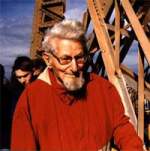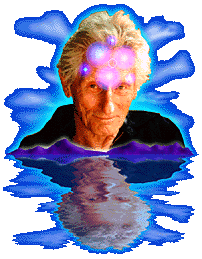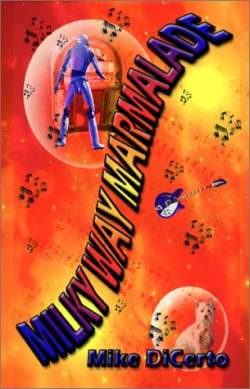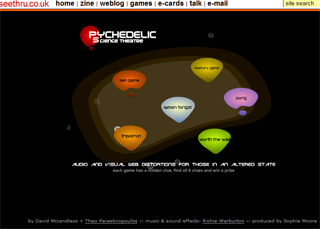May 31, 2004
Finite and Infinite Games: How to Live
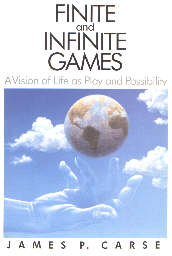
Via Kevin Kellys Cool Tools.
The wisdom held in this brief book now informs most of what I do in life. Its key distinction--that there are two types of games, finite and infinite--resolves my uncertainties about what to do next. Easy: always choose infinite games. The message is appealing because it is deeply cybernetic, yet it's also genuinely mystical. I get an "aha" every time I return to it.
A finite game is played for the purpose of winning, an infinite game for the purpose of continuing the play.
*
Finite players play within boundaries; infinite players play with boundaries.
*
To be prepared against surprise is to be trained. To be prepared for surprise is to be educated.
*
The death of an infinite player is dramatic. It does not mean that the
game comes to an end with death; on the contrary, infinite players
offer their death as a way of continuing the play. For that reason they
do not play for their own life; they live for their own play.
*
I can be powerful only by not playing, by showing that the game is over.
*
Infinite players do not oppose the actions of others, but initiate
actions of their own in such a way that others will play by initiating
their own.
*
Evil is the termination of infinite play.
*
No one can play a game alone.
*
There is but one infinite game.
Finite and Infinite Games
A Vision of Life as Play and Possibility
James P. Carse
1986, 180 pages
$7
Ballantine Books
Amazon
May 29, 2004
Trippiest Trip Report
Below is one of the most descriptive, far out and cosmic trip reports I've ever read. Originial report on Erowid.

DOSE : 50mg synthetic DMT in a glass pipe on a small bed of dill, three large, hot, plasticy tokes:
Upon inhalation, the trembling darkness before me crystallized instantly into a shimmering vortex of lime-colored tessera and began a meticulous implosion in upon itself. Pulses of sinuous electric energy shot along it from behind me and I could see them disappear down its infinite corridor. Each one came faster and faster and faster until this typhoon like tunnel was throbbing with supple, supernova pulsations. It was then that I began to accelerate, an auditory drone that seemed to flange at the edges of my being propelling me along. I couldn't believe the breakneck speed with which I was beginning to move, like a proton in a hyperspatial supercollider. The breathtakingly ecstatic sensation of being literally shot out of the confines of my corporeal body was overwhelming, and already my mind was grasping wildly about for some semblance of familiarity. No previous DMT journey had ever moved this fast. The vortex started coiling then, curling and cycling into its cylindrical self, and I became aware that it was but one strand in a warping and wefting dimension which was now materializing and taking on a thousand outlandish forms all around me. Ahead was an entirely ludicrous, tensile, concentric, mandala-like disco-medusa that wore about it a technicolor dreamcoat of fibrillating antennae, surrounded by an ultraviolet aura. Instantly I could tell it was alive: some sort of a sentinel. Then seemingly out of nowhere and from every direction at once came these freakish tentacles of liquid lapis lazuli. They began moving together with an almost orchestral hyperprecision, and I was completely mesmerized - it was like nothing I had ever seen. I had absolutely no idea what I was looking at - there must literally have been thousands of them - I was utterly flabbergasted. I knew I must find a way past this creature though, as extraordinary as she was. We were still cruising along at the speed of light, now descending backwards together through an amoeboid, octahedral gallery of iridescent vaults. It was at this moment that I became suddenly aware we were not alone. The vaults seemed to zoom explosively outward then and the gallery expanded ad infinitum into a gargantuan, labrynthine, almost interstellar space, and through every vault poured the miraculous and zany imps who make the tryptamine hyperdimension their home. The tentacles of lapis lazuli gathered these capricious, multi-colored enigmas in towards the center, and became the architectonic scaffolding of their new multi-dimensional reality, a world which I found myself dab smack in the middle of. It was like a liquid mind ecology of staggering and alien complexity, the mind as it crosses over into quantum warpdrive and migrates ever further out into the oceanic beyond. At this point the glorious geometries transcended what is even vaguely feasible in this three dimensional mundane, constantly concrescing into new and varigated permutations, exfoliating out of themselves what might be called hyperspherologies of the divine, and to look anywhere was to be shot clean through with scintillating amazement. Crowding and cramming themselves into my field of vision were thousands upon thousands of beings of every imaginable sort and many that were completely unimaginable. They were everywhere jabbering in indecipherable tongues, juggling incandescent neon microworlds of dancing beings, and morphing with a zen-like, diaphanous fluidity that remains a primal miracle no matter how often you lay your all too human eyes on it. The primordial intelligence being manifest before me was palpable, undeniable, transcendently amazing - it shook me to my core in a more-than-real gleeful profundity. All I could do was sit there in divine liquid awe, my soul gaping wide open, and stare at the incalculable proportions of bizarreness and the down right weird that lay before me. It was like being entertained by the 76,000 piece orchestra of an alien civilization in whose classical music each note is not merely a musical tone, but an entire world, each just as intricate and nuancical as our own. You have a sense of being swarmed by the whimsical mastermind artforms of an extremely eccentric Boolean contortionist, a diabolical merry go round of linguistic Rubix cubes, 13th dimensional millipedes saying themselves to themselves as they make love, and impossible Gordian knots dancing the jitterbug at a lyrical lightspeed: a gelatinous ballet of endlessly self-juxtaposing pirouettes. You realize all at once you have arrived and are now having darshan with this gigantically insectoid, otherworldly Oz.
They came at me again and again, a more than possible tsunami of opalescent combobulations, like rivers of music and miracles and clowns, the flood gates of my soul thrown wider than wide with the sheer magnitude of this dazzling, world-devouring spectacle. It was the primal, otherworldly bewilderness of the Andalusian gardens that grow in the antipodes of the mind, the crystalline vegetal perplexity of its delectable ecologies spilling and dripping and pouring like liquid diamonds from my eyes. The presence of what is awesome, what is wildly and passionately and numinously alive, filled every meridian in the vast continent of my expanded being, an intensity of joy and love and life coursing like heavenly ambrosia through my electrified veins. It was as though I myself was god, moving through liquid ecologies of god, the self-crystallizing emerald labyrinths of the tryptamine dreamtime, a marvelous infundibulum of plasmoidal calisthenics. What occurred was a total meltdown of everything I know and hold dear, utter surrender into the honeycomb lovewomb of the universe reborn, born anew in a thousand unendingly magnificent eyes, and Maya and Lila handheld spinning in sundream dandelions, my five senses spinning like a zillion gyroscopes round the centripetal amethyst of this all and everything.
I was there, and then I was back - zap like before - I was back before I even knew I was back, the dimensions subsiding very quickly within me as the last few molecules of DMT were cracked wide open and gone. The room before me buzzed and shimmered like the most unlikely dream. The world? Oh yes - I remember - I like it there. Hello people. You look so normal and good. But wait, something just happened. What was that thing? Oh YES, OH MY LORD YES.....everything was still a shimmering mindmirage or bliss and joy and awe. WOW...... I think I said that: WOW......
To think that we all spend hours there every night, after *we* have been metabolized away that is, and that every day the collectivity of human consciousness looks upon that miracle for over 50 billion hours, is more than any of us can even begin to begin to understand. Seven minutes spent in that dimension, the primal furnace of our being, is enough for most people to think about for the rest of their lives. How miraculously absurd and awe-inspiring is our situation as humans then, that we are somehow built around this certain little molecule, only four atoms away from serotonin, the neurotransmitter which mediates and colors every aspect of our waking lives. It is like the human body is a door, a portal, and DMT is the key that opens our experience to the all-possible, the everything dimension, which surrounds us on all sides though we see it not. That the simple quantum difference of four atoms can open this for anyone to see is, and will remain, the greatest, most mysterious enigma in this life. The day we unlock its secrets we will for the first time awaken from the dream.
** A reader pointed out to me that DMT, a substance found in the Amazon may have an anolog from a substance call phalaris in North America. You can read more about it here.
May 26, 2004
Into The Realm Of The Imagination
 Here's a bit from a Terence McKenna lecture in '93 which has been archived on Levity.org:
Here's a bit from a Terence McKenna lecture in '93 which has been archived on Levity.org:
History is a kind of indicator of the nearby presence of a transcendental object. And as we approach the transcendental object, history will become more and more hallucinatory, more and more dreamlike, more and more surreal--does this sound familiar to you? It's the neighborhood, right? [laughter] That's because we are so close now to this transcendental object, that is the inspiration for religion and vision and revelation, that all you have to do to connect up to it is close your eyes, smoke a bomber, take five grams of mushrooms in silent darkness, and the veil will be lifted, and you seen, then, the plan. You see what all these historical vectors have been pointing towards. You see the transcendental object at the end of time--a cross between your own soul and the flying saucer of cheap science fiction. I mean--the city of Revelations, hanging at the end of the Twentieth Century like a beacon. I really think that this is happening, and that what the-- It's as though we are boring through a mountain, towards someone else who is boring through that mountain, and there will be a handshake at a certain point in time. We are moving, literally, into the realm of the imagination. This is where the human future lies.
Psyop: Terror Warning
I'm sure you've all heard about the new terror warning. I've been predicting something like this since 9-11. The fact that this terror warning is happening now right before a pivotal election for Bush comes as no suprise to me. The timing seems way too convenient in light of Bush's plummeting popularity in the wake of the abuse scandal. And have you ever noticed that we always get such warnings right before a holiday? Such a tactic is textbook psyops, deliberately timed to maximize the "effect" of the psyop on the American psyche, while travelling Americans are most apt to think about it and feel vunerable to it. As Bush used to say, "Make no mistake", we are being psychologically prepared. It's long been my guess that if there is another strike, and unlike most everyone who keeps thinking it's inevitable (it isn't!!!), it will be perpetrated by our own elite.
Possibly with the help of the Israeli Massad, who for some very WEIRD reason has been caught twice in the last 3 weeks attempting to break into nuclear power plants in Georgia just miles from the upcoming G8 summit. If this doesn't raise your eyebrows I don't know what will! You can read all about it here, here and here.
You do the math. Even if they are telling the truth THIS time, I just can't bring myself to believe anything they have to say anymore. As far as I'm concerned this whole War on Terror is phony.
John Shirley has this to say over at his blog,
I think of General Franks saying that the Constitution might have to be suspended if there were a large enough terrorist attack. I think of his saying this in context of Bush being at risk of not being elected. Spikes of paranoia in my mind. WOuld the neocons detonate a small nuke and say the terrorists did it, just so Bush can declare martial law and suspend the election? Probably not--but people will say they did, if a bomb *is* set off. And you and I will probably never know for sure...I think of indications that the draft is coming back. Legislation to make it happen--with fewer exemptions. Notoriously WOlfowitz, Rove, Bush, and Cheney all got out of the draft through exemptions...that won't be available to young people when they're in charge, if my hearsay info on that is right.
So there's Franks' warning, there's plans for the draft, there's a warning about a major terrorist attack. There are warnings from Bush to Syria and Iran...
Meanwhile Bush would be empowered to invade those countries perceived as allies of Muslim extremists...and that's called World War Three...
Of course, I deeply, sincerely hope none of this ever comes to pass. It wouldn't make any economic sense for the elite to precipitate such a disaster. But then again, those in power seem to be getting more afraid all the time, and fearful people can do really stupid things.
Me, I do my best each day to remain positive, to love the people in my life, to spread cheer and good will everywhere I go. Perhaps positive thoughts and actions from enough of us can make a big enough difference to move us back on the path to survival and prosperity.
May 25, 2004
Dreams of Liberty? Or of Control?
Dale Carrico has written a brilliant critique of "negative" libertarianism. Regardless of where you fall on the "free market" issue, his critique brings up many salient points worth addressing.
Here are the concluding paragraphs from a longer essaylet, “Trouble in Libertopia,” over on Amor Mundi:
“Lately, I have begun to suspect that at the temperamental core of the strange enthusiasm of many technophiles for so-called "anarcho-capitalist" dreams of re-inventing the social order, is not finally so much a craving for liberty but for a fantasy, quite to the contrary, of TOTAL EXHAUSTIVE CONTROL. This helps account for the fact that negative libertarian technophiles seem less interested in discussing the proximate problems of nanoscale manufacturing and the modest benefits they will likely confer, but prefer to barrel ahead to paeans to the "total control over matter." They salivate over the title of the book From Chance to Choice (in fact, a fine and nuanced bioethical accounting of benefits and quandaries of genetic medicine), as if biotechnology is about to eliminate chance from our lives and substitute the full determination of morphology -- when it is much more likely that genetic interventions will expand the chances we take along with the choices we make. Behind all their talk of efficiency and non-violence there lurks this weird micromanagerial fantasy of sitting down and actually contracting explicitly the terms of every public interaction in the hopes of controlling it, getting it right, dictating the details. As if the public life of freedom can be compassed in a prenuptual agreement, as if communication would proceed more ideally were we first to re-invent language ab initio (ask these liber-techians how they feel about Esperanto or Loglan and you will see that this analogy, often enough, is not idle).
“But with true freedom one has to accept an ineradicable
vulnerability and a real measure of uncertainty. We live in societies
with peers, boys. Give up the dreams of total invulnerability, total
control, total specification. Take a chance, live a little. Fairness is
actually possible. Justice is in our reach. Radical technological
development regulated to ensure that costs, risks, and benefits are all
fairly shared can emancipate the world. Liberty is so much less than
freedom.”
May 24, 2004
Immortalist Utilitarianism
By Michael Anissimov from original article at Accelerating Future.
Step 1: Seeking Peak Experiences
Ever have a moment in your life that was just so great that you felt like jumping for joy, or crying in happiness? Many claim that these are the moments that make life worth living. The moment you finish writing a book, receiving a promotion, or sharing an intimate moment with someone special. How many "typical" days would you give for a single moment like that? Some might say 1, others 10, others even 100. Think about that - in a usual day, we're conscious for around 14 hours. Let's be conservative and suggest that the average John Doe would trade 5 typical days in exchange for a peak experience that lasts 5 minutes. The time ratio is about 1000:1, but many would still prefer the peak experience over the same old stuff.
This would imply that most people value life not only for the length of time they experience, but for the special moments that, as I mentioned earlier, "make life worth living". As the stereotypical quote goes, "Life is not measured by the number of breaths we take, but by the moments that take our breath away." Ethicists sometimes quantify such satisfaction as "utility" for the sake of thought experiments; we might say that each 5 minute peak experience is worth a thousand utility points, or "utiles". Correspondingly, each 5 days of typical activity would also count as roughly a thousand utiles, because one would trade one for the other. Although it may makesome of us uncomfortable to quantify utility, our brain is unconsciously performing computations accessing the potential utility of choices all the time,and the model is incredibly useful in the psychology of human decision makingand the field of ethics.
Following is an example of a typical human's lifelong utility trajectory. It plots utile-moments (u) against time (t). Let's say that the maximum u value reached is around 200 utiles/minute, or 1000 utiles for the 5 minute peak experience described above. For the sake of simplicitly, let's assume about 100 5-minute peak experiences per lifetime, and assume no other such experiences. Since peak experiences are so fun to have, much of the activity on "typical" days probably entails setting the groundwork for these experiences to happen; ensuring that one does not starve and so on.
The curve rises as the agent has a series of interesting new experiences, plateaus throughout most of adulthood, and subtly falls off in later years, until death is finally reached. It punctuates through peaks and valleys. Some might strongly associate utility with wealth or frequency of sexual activity, others might not.

Total utility: around 6,000,000 utiles, if we figure a lifespan of 80.
Step 2: Avoiding Premature Death
In life there is sometimes the danger of death. Death implies an immediate dropoff to the utility curve, a profoundly negative event. That's why people say stuff like "I'm too young to die!", or "I can't stop fighting, I have so much to live for". Humans despise death, because death is almost always a bad thing morally. People are willing to go out of their way to avoid it, and rightly so.
Let's introduce another aspect into the model. Say event X occuring at the
20-year mark has a probability 10% of eliminating all future
experiences, which adds up to a risk of 4,000,000 utiles. In emotional
terms, this would translate into arguments like those quoted above.
There are some things that people would be willing to sacrifice those
future experiences for. Just not too many of them. Death is a horrible
thing if it stands in the way of living a fulfilling life. Therefore,
it seems like a good idea to take actions to avoid event X if at all
possible. Actions and thoughts leading to the avoidance of X have high utility;
there are desirable in the same way that setting the groundwork for the
occurrence of a peak experience is desirable. That's why we are so
grateful when someone saves our life, and why we never drive under the
influence after that one nearly fatal car accident.
The two possible trajectories after the decision instance are represented by red and blue lines. If we die, experienced utility drops to zero immediately. If we survive, it's business as usual. The purple line represents the curve before it splits.
Total utility of blue trajectory: same as above, around 6,000,000
utiles.
Total utility of red trajectory: around 2,000,000 utiles. Ouch!
I'm sure you can imagine the utility trajectories for events such as
rehabilitating illness, serious injury, and so on. These things really suck, so
people devote a lot of effort to avoiding them, which is clearly a good thing.
Step 3: Life Extension
It has been shown scientifically that regular cigarette smoking can lead to a shorter life, either due to an increased probability of contracting lung cancer or for some other reason. It has also been shown that good nutrition, good genes, or regular exercise all contribute to longer lifespan. Hundreds of thousands of years ago, the average human lifespan was around 20, today it's four times longer; 80. Isn't that cool?
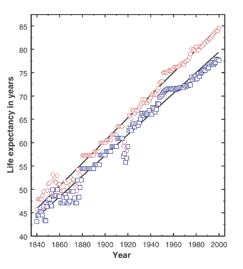
We're able to have a lot more interesting experiences per typical human life because our average lifespan has increased so greatly. This leads us to the notion that extending one's lifespan may be a worthy focus, a convenient path to increasing one's total experienced utility. We don't appreciate how lucky we are to live 80 years rather than a mere 20. Our entire culture has molded to the longer lifespans; it's now considered normal to live such long lives, so our default frame of reference tends to settle there. We should realize how spoiled we are relative to our ancestors, but also how transient and shallow our lives are from the perspective of a person with much longer life or more fulfilling experiences.
Say we want to add 5 years on to the end of our life by quitting cigarettes. This would imply that we value long life more than the short-term pleasure of a nicotine buzz. We may consider the added experiences and learning we could have as a result of this wise decision. We will have displayed the maturity to choose long-term benefits over short-term ones; some people might call this wisdom. I'm sure you can visualize the various utility trajectories and the desirability of choosing between them, but here is a picture anyway:

Here's where I start talking about potential sources of utility you might not
have heard of before.
Say that I have a few friends who offer to preserve the physical structure of my body in a deep freeze as soon as possible after my brain activity stops, and keep it that way until medical science advances to the point of being able to revive me safely. Let's say your friends happen to be employees of the Alcor Life Extension Foundation, and they've been doing these cryonic suspensions for years. Their services are relatively cheap - life insurance pays for the suspension as long as you pay the bills while you are alive.
There are a series of risks - the cryonics company could go out of business, nuclear war might occur, your brain decay might be too severe to reverse, and so on. But there is potentially an immense benefit. If a civilization has the technology and desire to revive a freshly preserved frozen body, then this same civilization probably has a great degree of control over biological processes in general. Aging occurs in humans because ordinary biological processes produce byproducts that the body fails to remove completely. So they build up in the body, causing decay. Keep in mind that most byproducts are removed, only a small percentage of the total remains. But that is enough to cause aging. Stopping aging is a matter of amplifying the human ability to self-regenerate - that is all. There is no mysterious mechanism that forces all organisms to perish at a certain age in order to comply with some Cosmic Order. Ensure that the byproducts of our biology are contained and removed, or not produced in the first place, and you have cured aging.
So we are faced with the decision posed to us by our friends, "would you like to sign up for cryonics, or not?" Let's say we're being extremely conservative, and only estimate the likelihood of a successful future revival at 0.1%. Let's say furthermore that our estimate of successful elimination of aging after the initial revival is only 10%, remaining conservative. But if revival and the aging cure are both successful, then let's say we figure our lifespan could be as long as 10,000 years, at which point we expect some random cosmic accident or war will wipe us out. Even though the civilization we are talking about probably has extensive control over all biological processes and extremely advanced technology, let's say our quality of life doesn't go much further above that which we experienced during our prime - a steady fluctuation of peak experiences and typical days. We also assume that one doesn't get bored during those ten thousand years, which shouldn't be too hard if the civilization is developing technologically and has plenty of new stuff to do. Many sci-fi, anime, and fantasy characters have lifespans on this scale, and they seem to be doing fine, so how hard could it be, right?

Character: Washu
Occupation: mad scientist
Age: over 10,000
Conclusion: 10,000 years is not so bad. In the future, it will be normal. The main challenge is aging.
So, what kind of utility function might a successful cryonics patient have?
Maybe something like that shown below. The curve dips down to zero when
the patient is frozen solid, and quickly jumps back up after revival.
(The squiggy line on the time axis implies that a ten thousand years
passes during that time.)

Total utility of complete trajectory: a whopping 750 million! Much
more impressive than a mere 6 million.
From the perspective of the pre-cryonics human being, experiencing the huge 10,000-year future lifespan is not certain. As we said; the estimation of successful revival is only 0.1%, and the estimation of an aging cure is 10%. Combine these, and we get an aggregated probability estimate of 0.01% that the whole thing will work at all. So we divide the expected utility of the outcome, 744 million utiles, by our probability estimate, 0.01%. The result is 74,400 utiles only. But what if paying our life insurance isn't that big of a dea to us, and the opportunity cost of the lost money only works out to 10,000 utiles or so? In that case, it would make sense to buy life insurance and sign up for cryonics - the expected utility exceeds the projected cost!
If the scenario matches that described above:
Total utility of "yes" answer: 6,074,000 utiles.
Total utility of "no" answer: 5,990,000 utiles.
Many people have made that decision. They tend to be well educated, successful, scientifically literate, and intelligent. Here is a short list by Ralph Merkle, plus a longer study of attitudes toward cryonics by W. Scott Badger. If our estimate of the probability of success goes up from 0.1%, the utility trajectories diverge even farther, and saying "yes" to cryonics seems to be an extremely compelling choice. The prospect of cryonics can contain a massive amount of expected positive utility.
Step 4: Extending Life for Everyone, Not Just Yourself
Stuff like cryonic suspension, regular exercise, good health, and so on, only apply to you. Other people don't benefit from these practices. Some of us care about humanity as a whole rather than just ourselves, our nation, or our clique, so we devote effort to technologies with the potential to grant more life to wide numbers of people. For example, respected Cambridge biogerontologist and co-founder of the Methuselah Mouse Prize, Aubrey de Grey, would like to extend the healthy human lifespan an order of magnitude or more beyond its current limits within the next twenty to fourty years. Yes, this is a serious strategy for workable anti-aging. He explains fully on his website, please feel free to read it thoroughly. From his proposed Institute outline, de Grey seems to be suggesting that a cure for human aging may come with a price tag of only $10-100m. Not so bad for the benefits, huh?
Let's say that you continue experiencing 1,000 utiles per 5 days of normal living, but also experience an additional 1 utile per 5 days for every 1,000 people whose lives are extended when they would have otherwise been snuffed out at the arbitrary age of 80 or whatever. "Added years" that people only get to experience as a result of this extreme life extension. If you feel that the success of de Grey's Institute will lead to an anti-aging therapy available to millions within the first decade of its release and billions within the third with a probability of, say, 25%, then contributing to this effort would be well worth the time and money. Since you care about each individual person that gets to experience the benefits of added life, it means a lot to you to raise the probability that the necessary anti-aging technology is widely available before they fall to the injustices of aging and premature death.
On his website, Aubrey mentions lifespans that exceed 5000 years. So, if the Institute is successful, then let's assume that translates into around five million people with five-millenia lifespans shortly after the technology is invented, around five hundred million people with lifespans of that length a decade after, and five billion people two decades after. Considering the fast global adoption of techologies such as the Internet and cell phones, this distribution pattern seems extremely conservative. People would surely be willing to focus on buying a drug that extends one's lifespan to 5000 healthy years or more. Possibly it could be a one-time thing, or "booster shots" might be required every few decades for negligible cost.
So, you find yourself with a million dollars. You can either buy a mansion or contribute the money to aging research. Your assumptons are roughly in line with those outlined above; you have examined Aubrey de Grey's arguments in detail and regard them as valid. The lives of other human beings are important to you and you feel satisfaction when their lives are extended. You want to compute the expected utility of both outcomes; how does the math work out?
- Say $1,000,000 is about 2% of the Institute's total financial requirements.
- So you are contributing 2% of the effort toward the Institute's success.
- If success is achieved, about five million people immediately get an extra 10 years of life.
- Every five days, you would get an extra 5,000 utiles in addition to the usual 1,000.
- After another decade, five hundred million people have the drug.
- That means five million more utiles per five days.
- After yet another decade, five billion people have it - half of Earth's projected population.
- You get fifty million utiles per five days.
- Let's say you feel the satisfaction for a total of another five decades before you get used to it.
- (When you get used to it, it becomes the new status quo, not really providing utility anymore.)
- Five decades times fifty million utiles per five days is... a lot.
So, the resulting utility graph is a bit more complicated:

Total expected utility of donation: massive; billions of utiles or more.
Total expected utility of a mansion: not nearly as much.
Utility goes up more and more as additional lives are saved. This graph assumes that one considers the lives of all those living after his or her life to be meaningless. In real life, people often feel otherwise. The fuzziness of to the right side of the graph represents our uncertainty about the long-term consequences - 5,000 years may turn out to be a ridiculously low estimate, and our real lifespans may lie in the realm of the millions or even billions - who knows! If there are no huge cosmic disasters, no war, and you can repair yourself or back up your memories at a whim, who's to say that your lifespan won't be as long as that of the universe?
You'll also notice that the utility axis has been expanded in the upward direction. That's because contributing to the extended life of millions or billions of people is (presumably) a bigger deal than only extending your own life. Engineering the human brain to better experience pleasure may be another may to increase total utility, or perhaps through enhancing our intelligence, empathy, creativity, and so on. These speculations are the province of transhumanism. Feel free to read up on the topic if you're interested in learning more. See also the question on our FAQ, "wouldn't it be boring to live forever in the perfect world?"
Step 5: The Greatest Threat to Life - Existential Risk
 The
value of contributing to Aubrey de Grey's anti-aging project assumes
that there continues to be a world around for people's lives to be
extended. But if we nuke ourselves out of existence in 2010, then what?
The probability of human extinction is the gateway function through
which all efforts toward life extension must inevitably pass, including
cryonics, biogerontology, and nanomedicine. They are all useless if we
blow ourselves up. At this point one observes that there are many
working toward life extension, but few focused on explicitly preventing
terminal global disaster. Such huge risks sound like fairy tales rather
than real threats - because we have never seen them happen before, we
underestimate the probability of their occurrence. An existential
disaster has not yet occurred on this planet.
The
value of contributing to Aubrey de Grey's anti-aging project assumes
that there continues to be a world around for people's lives to be
extended. But if we nuke ourselves out of existence in 2010, then what?
The probability of human extinction is the gateway function through
which all efforts toward life extension must inevitably pass, including
cryonics, biogerontology, and nanomedicine. They are all useless if we
blow ourselves up. At this point one observes that there are many
working toward life extension, but few focused on explicitly preventing
terminal global disaster. Such huge risks sound like fairy tales rather
than real threats - because we have never seen them happen before, we
underestimate the probability of their occurrence. An existential
disaster has not yet occurred on this planet.
The risks worth worrying about are not pollution, asteroid impact, or alien invasion - the ones you see dramaticized in movies - these events are all either very gradual or improbable. Oxford philosopher Nick Bostrom warns us of existential risks, "...where an adverse outcome would either annihilate Earth-originating intelligent life or permanently and drastically curtail its potential." Bostrom continues, "Existential risks are distinct from global endurable risks. Examples of the latter kind include: threats to the biodiversity of Earth’s ecosphere, moderate global warming, global economic recessions (even major ones), and possibly stifling cultural or religious eras such as the “dark ages”, even if they encompass the whole global community, provided they are transitory." The four main risks we know about so far are summarized by the following, in ascending order of probability and severity over the course of the next 30 years:
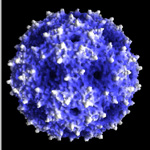 Biological.
More specifically, a genetically engineered supervirus. Bostrom writes,
"With the fabulous advances in genetic technology currently taking
place, it may become possible for a tyrant, terrorist, or lunatic to
create a doomsday virus, an organism that combines long latency with
high virulence and mortality." There are several factors necessary for
a virus to be a risk. The first is the presence of biologists with the
knowledge necessary to genetically engineer a new virus of any sort.
The second is access to the expensive machinery required for synthesis.
Third is specific knowledge of viral genetic engineering. Fourth is a
weaponization strategy and a delivery mechanism. These are nontrivial
barriers, thankfully.
Biological.
More specifically, a genetically engineered supervirus. Bostrom writes,
"With the fabulous advances in genetic technology currently taking
place, it may become possible for a tyrant, terrorist, or lunatic to
create a doomsday virus, an organism that combines long latency with
high virulence and mortality." There are several factors necessary for
a virus to be a risk. The first is the presence of biologists with the
knowledge necessary to genetically engineer a new virus of any sort.
The second is access to the expensive machinery required for synthesis.
Third is specific knowledge of viral genetic engineering. Fourth is a
weaponization strategy and a delivery mechanism. These are nontrivial
barriers, thankfully.
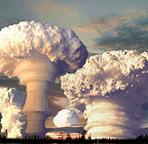 Nuclear.
A traditional nuclear war could still break out, although it would be
unlikely to result in our ultimate demise, it could drastically curtail
our potential and set us back thousands or even millions of years
technologically and ethically. Bostrom mentions that the US and Russia
still have huge stockpiles of nuclear weapons. Miniaturization
technology, along with improve manufacturing technologies, could make
it possible to mass produce nuclear weapons for easy delivery should an
escalating arms race lead to that. As rogue nations begin to acquire
the technology for nuclear strikes, powerful nations will feel
increasingly edgy.
Nuclear.
A traditional nuclear war could still break out, although it would be
unlikely to result in our ultimate demise, it could drastically curtail
our potential and set us back thousands or even millions of years
technologically and ethically. Bostrom mentions that the US and Russia
still have huge stockpiles of nuclear weapons. Miniaturization
technology, along with improve manufacturing technologies, could make
it possible to mass produce nuclear weapons for easy delivery should an
escalating arms race lead to that. As rogue nations begin to acquire
the technology for nuclear strikes, powerful nations will feel
increasingly edgy.
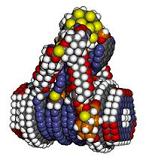 Nanotechnological. The Transhumanist FAQ reads,
"Molecular nanotechnology is an anticipated manufacturing technology
that will make it possible to build complex three-dimensional
structures to atomic specification using chemical reactions directed by
nonbiological machinery. "Because nanomachines could be
self-replicating or at least auto-productive, the technology and its
products could proliferate very rapidly. Because nanotechnology could
theoretically be used to create any chemically stable object, the
potential for abuse is massive. Nanotechnology could be used to
manufacture large weapons or other oppressive apparatus in mere hours;
the only limitations are raw materials, management, software, and heat
dissipation."
Nanotechnological. The Transhumanist FAQ reads,
"Molecular nanotechnology is an anticipated manufacturing technology
that will make it possible to build complex three-dimensional
structures to atomic specification using chemical reactions directed by
nonbiological machinery. "Because nanomachines could be
self-replicating or at least auto-productive, the technology and its
products could proliferate very rapidly. Because nanotechnology could
theoretically be used to create any chemically stable object, the
potential for abuse is massive. Nanotechnology could be used to
manufacture large weapons or other oppressive apparatus in mere hours;
the only limitations are raw materials, management, software, and heat
dissipation."
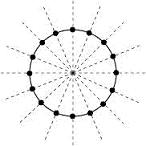 Human-indifferent superintelligence. In the near future,
humanity will gain the technological capability to create forms of
intelligence radically different than our own. Artificial Intelligences
could be implemented on superfast transistors instead of slow
biological neurons, and eventually gain the intellectual ability to
fabricate new hardware and reprogram their source code. Such an
intelligence could engage in "recursive self-improvement" - improving
its own intelligence, then directing that intelligence towards further
intelligence improvements. Such a process could lead far beyond our
current level of intelligence in a relatively short time. We would be
helpless to fight against such an intelligence if it did not value our
continuation.
Human-indifferent superintelligence. In the near future,
humanity will gain the technological capability to create forms of
intelligence radically different than our own. Artificial Intelligences
could be implemented on superfast transistors instead of slow
biological neurons, and eventually gain the intellectual ability to
fabricate new hardware and reprogram their source code. Such an
intelligence could engage in "recursive self-improvement" - improving
its own intelligence, then directing that intelligence towards further
intelligence improvements. Such a process could lead far beyond our
current level of intelligence in a relatively short time. We would be
helpless to fight against such an intelligence if it did not value our
continuation.
So let's say I have another million dollars to spend. My last million dollars went to Aubrey de Grey's Methuselah Mouse Prize, for a grand total of billions of expected utiles. But wait - I forgot to factor in the probability that humanity will be destroyed before the positive effects of life extension are borne out. Even if my estimated probability of existential risk is very low, it is still rational to focus on addressing the risk because my whole enterprise would be ruined if disaster is not averted. If we value the prospect of all the future lives that could be enjoyed if we pass beyond the threshold of risk - possibly quadrillions or more, if we expand into the cosmos, then we will deeply value minimizing the probability of existential risk above all other considerations.
If my million dollars can avert the chance of existential disaster
by, say, 0.0001%, then the expected utility of this action relative to
the expected utility of life extension advocacy is shocking. That's
0.0001% of the utility of quadrillions or more humans, transhumans, and
posthumans leading fulfilling lives. I'll spare the reader from working
out the math and utility curves - I'm sure you can imagine them. So,
why is it that people tend to devote more resources to life extension
than risk prevention? The follow includes my guesses, feel free to tell
me if you disagree:
- They estimate the probability of any risk occurring to be extremely low.
- They estimate their potential influence over the likelihood of risk to be extremely low.
- They feel that positive PR towards any futurist goals will eventually result in higher awareness of risk.
- They fear social ostracization if they focus on "Doomsday scenarios" rather than traditional extension.
Those are my guesses. Immortalists with objections are free to send in their arguments, and I will post them here if they are especially strong. As far as I can tell however, the predicted utility of lowering the likelihood of existential risk outclasses any life extension effort I can imagine.
I cannot emphasize this enough. If a existential disaster occurs, not only will the possibilities of extreme life extension, sophisticated nanotechnology, intelligence enhancement, and space expansion never bear fruit, but everyone will be dead, never to come back. This would be awful. Because the we have so much to lose, existential risk is worth worrying about even if our estimated probability of occurrence is extremely low.
It is not the funding of life extension research projects that immortalists should be focusing on. It should be projects that decrease the risk of existential risk. By default, once the probability of existential risk is minimized, life extension technologies will be developed and applied. There are powerful economic and social imperatives in that direction, but few towards risk management. Existential risk creates a "loafer problem" - we always expect someone else to do it. I assert that this is a dangerous strategy and should be discarded in favor of making prevention of such risks a central focus.
Organizations explicitly working to prevent existential risk:
Center for Responsible Nanotechnology
Advanced nanotechnology can build machines that are thousands of times
more powerful—and hundreds of times cheaper—than today's devices. The
humanitarian potential is enormous; so is the potential for misuse. The
vision of CRN is a world in which nanotechnology is widely used for
productive and beneficial purposes, and where malicious uses are
limited by effective administration of the technology. An important
organization doing genuinely valuable, positive work.
Singularity Institute for Artificial Intelligence
The Singularity Institute for Artificial Intelligence is a nonprofit
corporation dedicated solely to the technological creation of
greater-than-human intelligence. The Singularity Institute sees no
reason why we won't be able to eventually build such intelligences - it
basically burns down to an engineering problem. If the first
greater-than-human intelligence were a benevolent one, it could use its
intelligence to further improve its own intelligence, the intelligence
of human beings, and assist others in the pursuit of humanitarian
causes.
Thank you for your attention!
Michael Anissimov
Grant Morrison, 2012, & the Supercontext
There's a new interview with comic mage Grant Morrison, author of The Invisibles, Doom Patrol, Arkham Asylum, and the current run of The X-Men. Here's an excerpt:
CXF: Last, but certainly not least. It's December 22, 2012. As humanity takes its last wistful look at the constraints of space-time and dives headlong into the Supercontext, where is Grant Morrison?[Thanks to New World Disorder for the link.]GM: Shagging like bloody Shiva, I hope. I think that if anything happens at all, it's most likely to come in the form of a mass consciousness change - possibly triggered by planetary electromagnetic field alterations predicted to occur around that time - so that basically everyone will start peaking on the acid trip that never ends. 'Individuality' will dissolve and your minds will start to merge into one mass mind, which is likely to seem quite frightening and overwhelming, especially for the sheltered minds, and time will seem to disappear as we identify with the mitochondria in our cells, instead of identifying with the physical individual carrier 'bodies' we use to expedite the shuffling around of DNA.
The world's current social structures should collapse quite rapidly when that happens and chances are, only people capable of handling the immense influx of new information will be those already familiar with heavily-altered states of consciousness. For everyone else, it will seem like the Second Coming, the arrival of the Space Brothers, the Rapture, Hell on Earth, the 32nd path of the Tree of Life or whatever they decide to see - everyone will get their own personal apocalyptic transfer into this new mode of being. Some poor souls will have to be guided out of hell, others will have to be coaxed down from sci-fi Ultraspheres but we'll all be living in a state of permanent psychedelic ecstasy and will have to restructure our entire existence to cope with the new consciousness. I have a feeling that psychedelic drugs provide a flashforward glimpse of this kind of consciousness and help prepare the human mind for when that mode of consciousness is permanent.
If something like this occurs at the end of 2012, and it's also possible that nothing of note will happen - we should see a lot of people freaking out when we re-enter what some Australian aboriginals call Aljira (a word English is not up to the task of translating, so it comes out as 'Dreamtime') and I call 'the Supercontext'. When we see in a new way and become new to ourselves, we'll also see lots of stuff that will probably scare people who didn't know it was there all along. People in delirium and on the brink of death see these crawling, replicating 'wilkie-swilkie men' all over everything and soon, I think, everyone will start to see them. They are 'the spaces between things, come to life…'
As for me, I hope I'll be screaming 'Yes!' like Molly Bloom as the universe rolls up into a silver paper ball for the quantum cats of Hell to play with.
May 23, 2004
Life, Universe and Everything
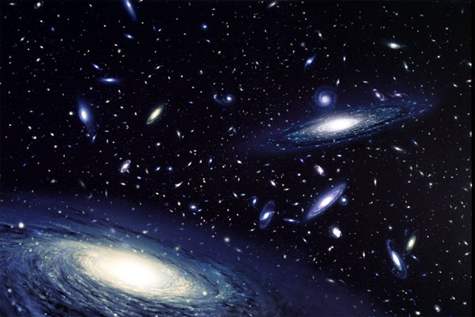
There has been a several decades long debate about whether extra-terrestrial intelligence exists. As more data comes in about the nature of our universe, I think the odds are rapidly approaching 100% in the affirmative.
According to this recent story our universe is at least 78 billion light years radius or 156 billion light years across, minimum. The scientists are quick to point out this minimum size is based soley on a lack of instrument sensitivity, and a mild adjustment in instrument accuracy is likely to push this minimum to at least 192 billion light years across. They also point out the actual size of the universe is probably exponentially much larger.
Some people find these figures confusing since the age of our universe has been pinned down to 13.7 Billion years, or 14.7 Billion years according to this article. So they ask how could the universe expand to a size of at least 78 billion light years radius in only 13.7 billion years? The reason for this rapid early expansion is inflation. The speed of light wasn't violated, as it was the expansion of space itself that exceeded the speed of light.
So how big is our universe?
HUGE
So huge in fact that I'm going to have to play around with scales so you can get a better idea.
According to the standard inflationary model of cosmology, the visible portion of our universe; the one mapped by our telescopes is an infinitesimally small speck in a much larger universe of at least a 1035 light-year across! I admit this number is really, really big, and almost impossible to imagine. So lets shrink everything down, WAY down, just so we can get a better grasp of it. Let's imagine that the entire universe that we have seen in all the world telescopes, all the galaxies, all trillion of them, extending out 13 billion light years in every direction is shrunk down to the size of a golf ball. Now you are holding the entire visible universe in the palm of your hand. So how big is the actualy 1035 lightyear universe in comparison? If we do a volume calculation, the actual universe contains 1060 of those golf balls! Wow, I guess we didn't shrink things down far enough, but this will have to do. So how big a volume would 1060 golf balls fill up? Try a sphere 850 light years across! So imagine a mass of golf balls that big, and each one of those golf balls contains all the stars and galaxies that we can see through our telescopes.
This is still almost beyond imagining, so lets take a slightly different approach. Imagine you are travelling so fast that you can go from on end of the galaxy to the other in just one second. That's a speed of 100,000 ly/sec. At this speed the entire galaxy would be in reach before you can say the word "go", and wam, you're there. At this speed, you could travel to the nearest galaxy Andromeda in 22 seconds. And you could cross from end of the visible universe to the other in 72 hours. Continuing on at this speed, it would take 115 days to travel a trillion light years, 315 years to travel a quadrillion, and 315,000 years to travel a quintillion or 1018 light years. And yet you have barely moved at all in comparison to the universe which is 1035 light years across. So, lets speed up our warp vehicals again, so that we can travel a quintllion light years every second. At such a speed we could cross the known universe 100 million times in one second. Ok, so now that we are travelling at a speed that might as well be infinite, how long would it take to cross from one side of the univese to the other?
Some physicists such as Max Tegmark believe the universe is actually infinite in size.
If the galactic density of our own neighborhood is typical across this
entire domain, and according to the data from the satellite COBE it is,
then our bubble-universe should contain at least another 10100
galaxies. This is such a large figure, that it's difficult to explain
it. So to give you an idea of how large a number this is, it's far
larger the the number of atoms that compose every object in our own visible universe,
which as you remember extends out 13.2 billion light years in every
direction. This too is very difficult to conceptualize. So we'll have
to scale down even further to a grain of sand. The number of atoms
composing a gran of sand is about 1023 atoms, or 100
trillion trillion atoms for each grain of sand on a typical beach. And
just think how many grains of sand are on your typical beach, let alone
something the size of the Sahara. And that's just on the surface of the
earth. All the sand in the world composes much less than 0.00001% of
the mass of the earth. The number of atoms composing the Earth is about
1060. And the Earth in turn is one tiny planet around a
small star in an ordinary galaxy, among hundreds of billions of
galaxies in our very local neigborhood, which we call the visible universe. So 10100
is a very very big number of galaxies! Adding it all together and you
get more galaxies in our universe than there are atoms composing every
object in our visible universe.

Even if intelligent life is very, very rare, a number as large as 10100 is still likely to produce an abundance of life throughout the universe. A place where countless lifeforms evolve beyond their womb planets into highly advanced space-faring civilizations.
For arguments sake, lets imagine that primitive life happens once in the lifetime of a trillion galaxies, and out of those only one in a trillion ever evolves out of its womb planet into a space-faring civilization. In this example then we are still left with an astounding 1075 advanced societies - more alien cultures than the number of atoms composing planet Earth! Again, for some perspective on such a gargantuan number, there are more advanced civilizations partying it up around the galaxies than there are atoms in every single grain of sand on all the beaches and deserts in the world, and then some. That's more advanced alien civilizations than all the atoms composing our entire solar system!
Assuming life were this rare (and that's very unlikely, even with the Rare Earth Hypothesis), then our nearest star-hopping neighbors would probably be trillions of light-years away. If somehow the speed of light remains a barrier, then we might as well be alone, since we could never make contact with each other before the universe ended. However, I think such barriers will be smashed shortly after the singularity bottleneck. My guess is shortly after a civilization passes through their singularity, the entire universe will be in reach. Already scientists have found loopholes in this light speed barrier. According to Michael Alcubierre, we could hypersurf space-time using exotic matter, allowing the craft to exceed the speed of light by any desirable amount. Then there are traversible wormholes. For an enlightening discussion of some possible scenarios, see Michael C. Price's Some Implications of Traversible Wormholes.
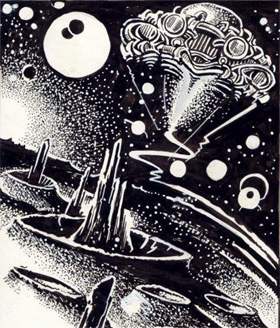
So the problem won't be reaching any part of the universe, that will be childs play. The real challenge will be deciding which parts of the universe to go to. The divide between what is available, and what is conceivable would be enormous! According to Michael Price, the number of civilizations making contact with each other would exceed the ability of any civilization to fathom. According to Price, the implications of such 'Contact' would be staggering, the number of alien cultures would be so large, that it is unlikely anyone could ever catalog all of them, even if they did have computers the size of Jupiter. No historian could encompass the sweep of history, no biologist catalog the species. In a profound sense we'll have returned to a vast ancient world, surrounded by distant lands populated with mythical and fantastic creatures. Construction of a single universal map would be impossible.
trans-species designation code (a seventy digit number!)
she would never, ever find her way home again.
None of her descriptions of where she comes from
would relate to anything anyone else knows."
The culture shock of trying to absorb such a vast amount of new data would take close to eternity... an eternity of never ending expansion, novelty and adventure.
Related Posts
Singularity Exo-Paleontology
Exotic Civilizations: Beyond Kardaschev
Sans-Ceiling Hypothesis
Listening to: Ozric Tentacles - Erpsongs - Tidal Otherness.
May 22, 2004
Alex Grey At Burning Man 2003
Pelenque Norte is hosting an mp3 archive of a talk given by renowned visionary artist Alex Grey and his wife Allyson. The talk - titled Art, Love, & Psychedelics - was presented at last year's Burning Man.
It was hot. It was dusty. It was Friday, and it was noon in the desert. But that didn't prevent the Palenque Norte conversation with the Grey's from being one of the best-attended daytime events of Burning Man 2003. After a spectacular Thursday night of revelry, when the citizens of Black Rock City would normally still be asleep, a small crowd began to form Aetheria Village's lecture pod. By noon the pod was packed, bicycles and people filled the village's common areas, and several art-cars were parked within range of our sound system. Later we were told that additional hundreds listened to the Grey's on KPOD, our village radio station. For many of this year's burners, it was one of their most talked-about events. Now, those of you who couldn't attend this wonderful presentation can hear it in the comfort of your home (or wherever your Internet connection is :-).
May 21, 2004
Was Universe Created By Design?
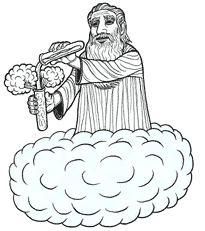
I just read this article over at Slate. Ever since I heard of basement universes and the possibility of our future selves creating them for our own amusement (see Linde Scenario), it seemed all the more likely that our own universe was created by an advanced intelligence from another universe.
Was our universe created? That is, was it brought into being by an entity with a mind? This is a question I began pondering after my recent inquiry into the end of the universe. (For some reason, cosmic mysteries are best contemplated in pairs.) It is the fundamental issue that separates religious believers, ranging from Deists to Gnostics to Southern Baptists, from nonbelievers. To many atheists, the very idea that our world could have been created by a conscious being seems downright nutty. How could anyone, even a god, "make" a universe?To get a better understanding of this matter, I thought it might be wise to consult the man who has done more than anyone else to explain how our universe got going. His name is Andrei Linde, and he is a physicist at Stanford University. (He's also an artist and an acrobat, but never mind.) In the early 1980s, the then-thirtysomething Linde came up with a novel theory of the Big Bang that answered three vexing questions: What banged? Why did it bang? And what was going on before it banged? Linde's theory, called "chaotic inflation," explained the shape of space and how galaxies were formed. It also predicted the exact pattern of background radiation from the Big Bang that was observed by the COBE satellite in the 1990s. Linde has been amply honored for his achievement, most recently by being awarded the 2004 Cosmology Prize of the Peter Gruber Foundation (along with Alan Guth, another pioneer of the theory of cosmic inflation).
Among the many curious implications of Linde's theory, one stands out for our present purposes: It doesn't take all that much to create a universe. Resources on a cosmic scale are not required. It might even be possible for someone in a not terribly advanced civilization to cook up a new universe in a laboratory. Which leads to an arresting thought: Could that be how our universe came into being?
May 19, 2004
Lightful Construction
Dymaxion 4D Lightful Dwellings by Buckminster Fuller:
In 1927, in the privately circulated draft entitled 4D, later printed as part of 4D Timelock Fuller outlined his vision of shipping mass-produced houses around the world by Zeppelin, to be accessible by means of small planes capable of prolonged ground-taxiing.
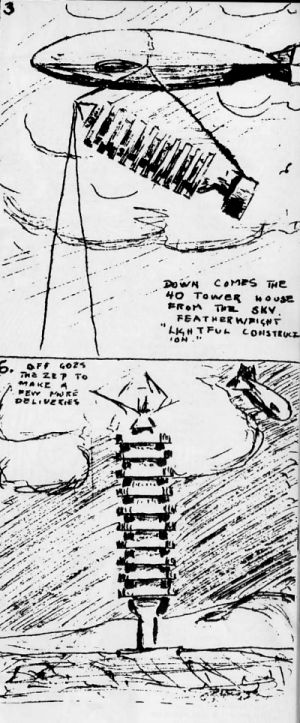 Fuller
actually described the 10 deck houses shown here as "stepping stone,
world airline maintenance crew environment controls", the idea being
that, if appropriately distributed around the globe, they could serve
as maintenance stations for planes on great circle air routes.
Fuller
actually described the 10 deck houses shown here as "stepping stone,
world airline maintenance crew environment controls", the idea being
that, if appropriately distributed around the globe, they could serve
as maintenance stations for planes on great circle air routes.
Fuller was convinced that his plan for mass-produced housing would render city-dwellings obsolete.
In July 1928, he wrote to his mother who was in their home in Bear Island, Maine, suggesting that the value of island property would be radically increased once his ideas took effect. He advised his mother to sell their house in Cambridge Massachussetts immediately, as the price of urban real estate was bound to fall dramatically:
"If the rest of the family want to keep their money in land, I should recommend transferring the money for the sale of the Cambridge property to the purchase of additional islands, picked for their landing facilities. In a year or so, when my 4D houses are ready, we will be able to put them up on the islands in one day, with every facility of modern city luxury built in, quite as comfortable in winter as any other time, on the installment plan, for a dollar down... There is no question that what I have predicted will come about."
The 4D-transport, that later developed into the dymaxion automobile, was initially intended as a private vehicle suited for this new decentralized human condition. Its primary role would be for flight between island dwellings. For ground-use, it would have to be capable of taxiing for long distances.
Well, Bucky was sure an optimist. But why not? Why shouldn't we get lightweight buildings delivered by zeppeliner or helicopter? Why does an average one-family house need to weigh 150 tons and take a number of months to construct? It makes sense to use as little resources as possible, and arrange the production procedures for fast and easy delivery.
May 17, 2004
eyeBlogging
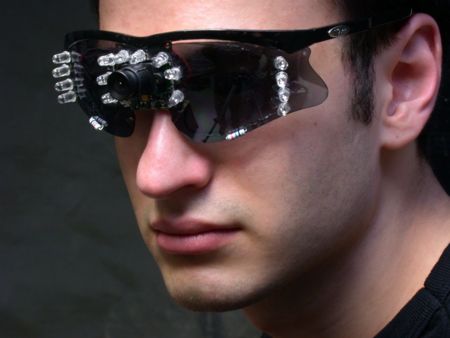
From Slashdot:
"Researchers at Human Media Lab, Queen's University in Canada presented the ECSGlasses: eye contact sensing glasses that report when people look at their wearer. When eye contact is detected, the glasses stream this information to appliances to inform these about the wearer's engagement. According to HML.Blog the ECSGlasses uses a wearable, wireless Eye-Contact Sensor (1.3MB .jpg) to gauge when the user receives eye-contact from an onlooker. eyeBlog uses this information to record and publish face-2-face conversations without dividing the user's attention between the event being recorded, and the device being used to record it. Moreover, because eyeBlog uses eye-contact to start and stop recording, users do not need to sift through hours of footage to find interesting segments. If you are the academic type you can read the paper (2.2MB .pdf), otherwise the video in .mpg (1:49min, 320x240, 7.5MB), or mp4 (1:49min, 320x240, 4.9MB) should explain everything. Video Mirror: .mp4 .mpg."That is weird and cool, of course. I'm not sure why I'd only want to capture people's picture when they're looking at me, but it could be useful added information of course. Like, if it were combined with face recognition software, and my glasses tells me who somebody is just before they start talking to me. There are some obvious problems in the scheme, of course, like that not everybody looks at each other when they're conversing, and the norms for this change from culture to culture. But just the ability to capture the picture of everybody who looks at me could ensure that I have the most obvious source material for good pictures of them. The glasses look kind of bizarre, with a series of LEDs bouncing light off of people's faces, and back into a cyclops camera in the middle. That itself would be enough to get people to stare directly at you. In horror, maybe. But I bet there are ways of making it all smaller and less visible.
May 16, 2004
Mobutobe
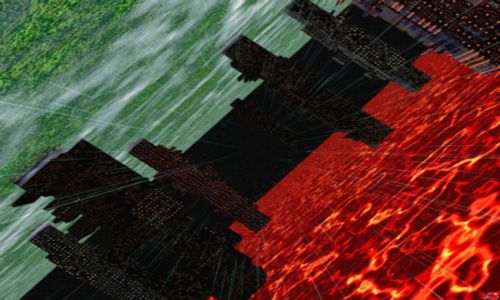
Mobutobe. It is mostly a joke, I think, but stimulating for thought nevertheless.
MOBUTOBE refers to the calculations of Isaac Asimov. The biologist and author published in 1971 that there are 20 trillion (20 x 10^12) tons of live cells on earth. 10 percent of these (that is two trillion tons) are animal cells. This number has to be regarded as the maximum level, for vegetable life cannot increase in quantitiy without an increase of sunlight or a refinement of its capability to process sunlight.The latter sounds like they got it wrong. I suppose it means that the percentage of animal cells can't get higher, as animals need to feed on vegetable cells.
Animal life is heterotrophic, it lives on plants that metabolise energy from the sun into chemical energy. Animal life cannot be increased in quantitiy without an increase of the plants it feeds on. The number of humans shall continue to increase! The earth is capable of nourishing a maximum mass of human life equalling the momentary total mass of animal life. That would be no less than 40 trillion (40 x 10^12) people. The maximum average of people living on earth for ideal MOBUTOBE population would be 80.000 people per square kilometer. Each and every square kilometer of surface would be occupied.OK, they're kidding. We don't really want that. But at the same time, there's a point. It is possible. If we really applied the planetary resources towards supporting the maximum biomass, in particular the maximum quantity of human biomass, then one could imagine some construct like that. I don't know how they get to the 40 trillion, but, yes, that would be around 80,000 per square kilometer, if we covered the whole surface. It would look like Trantor, but it would be possible, with a lot of engineering and planning of the food chain. Makes you think. Would be a horrible idea. But it shows that as it is now we're just really bad at managing resources and understanding natural cycles, as we're messing up the place to support a mere 6 billion people, and badly at that.MOBUTOBE propagates the construction of a multi-story building complex spanning the whole planet!
The building complex shall be constructed like this: The roof is reserved for plant cultivation. Edible algae as well as higher plants that are manipulated so that they are esculent as a whole are cultivated there. Regular supply is easily provided. Equispaced at small intervals, pipes are mounted that transport water and plant products to the lower levels. These materials are processed into food while the water is stored in tanks on the roof. Different pipes transport manure (consisting of human excrements and manipulated remainders of corpses) up to the roof.
May 15, 2004
X-Prize To become Annual Event
Wow again. Now that the X-Prize is likely to be won this year, it's now going to become an annual event in New Mexico.
Entrants in the races, scheduled to begin in the summer of 2006 after an exhibition the preceding year, will include many of the participants in the current Ansari X Prize Competition. The winner of that $10 million prize will be announced later this year.
Nearly 30 teams from seven nations are competing in that contest to design and build a spaceship capable of sending three passengers 60 miles into space and returning them safely. Those launches are under way at sites around the world.
After that event, the runners-up and other teams will focus on the New Mexico event, which will be the next stage in the mission of the X Prize Foundation to the further development of safe, cost-effective space transportation for the general public.
"Teams and their fans from around the world will gather annually in New Mexico to participate in the competition for the X Prize Cup," said Peter Mitchell, director of the Office of Space Commercialization in Santa Fe.
Rick Homans, secretary of the New Mexico Economic Development Department, said the ultimate goal of the competition is to encourage space commercialization.
"As the times get faster and faster, it means we are getting better at commercializing space and the cost is coming down," he said. "That's what this is all about, to drive the industry."
The entrants will compete for the fastest turnaround, maximum passengers per flight, maximum altitude and fastest flight from takeoff to landing. Winners will receive cash prizes and international media attention.
Thanks for the link Sauceruney.
May 14, 2004
Rutan's SpaceshipOne Goes Up 41 Miles!
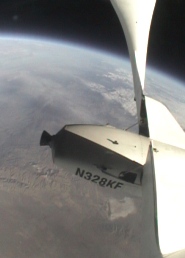
This is exciting stuff. Burt Rutan's Spaceship on its third test flight went 2/3 of the way to space. I'm now very optimistic it will win the X Prize before this year is over, of going to space (61 miles up) twice in two weeks.
Chalk up another booming flight of the privately-backed SpaceShipOne, the piloted rocket plane designed to soar to the edge of space and glide to a runway landing.With pilot Mike Melvill at the controls -- following release from the White Knight turbojet-powered launch aircraft high above the Mojave, California desert -- SpaceShipOne punched through the sky today boosted by a hybrid propellant rocket motor.
Scaled Composites of Mojave is the builder of SpaceShipOne, an effort led by aviation innovator, Burt Rutan. The financial backer of the project is Microsoft mogul, Paul Allen.In a post-flight statement from the company, the SpaceShipOne team reported that their space plane flew to 212,000 feet altitude, almost 41 miles. NASA awards astronaut status to anyone who flies above 50 miles in altitude.
May 13, 2004
Masturbate Online
Annalee Newitz, who wrote an article that inspired this site, writes in her latest Techsploitation:
In the "we're not sure we're part of the United States" Bay Area, we like to enjoy a little masturbation with our free speech. Politics should feel good! That's why Carol Queen and Robert Lawrence, founders of the nonprofit Center for Sex and Culture, are hosting a public Masturbate-a-thon May 15. All proceeds from the event – which is set up like a walkathon, with sponsors donating a certain amount for each masturbator – benefit the center, which is raising money for a permanent space. And what's truly cool is that the whole deal will be broadcast live on the Web (www.masturbate-a-thon.com). It's just one way the Internet allows us to share our Bay Area values with the world.
May 12, 2004
Promise of Artificial Photosynthesis

A new article in this months Prospect Magazine by Philip Hunter discusses some recent breakthroughs in making artificial photosynthesis a practical reality.
It is still unclear where most of our energy will come from in the longer-term future. Solar power cannot produce industrial quantities of electricity, while the tide is turning against wind turbines because they spoil the landscape and too many would be needed to replace conventional generators. Nuclear energy remains in the doldrums. Fossil fuels continue to threaten global warming.But a promising new contender is emerging: the harnessing of photosynthesis, the mechanism by which plants derive their energy. The idea is to create artificial systems that exploit the basic chemistry of photosynthesis in order to produce hydrogen or other fuels both for engines and electricity. Hydrogen burns cleanly, yielding just water and energy. There is also the additional benefit that artificial photosynthesis could mop up any excess carbon dioxide left over from our present era of profligate fossil fuel consumption.
As we learned in school, photosynthesis is the process by which plants extract energy from sunlight to produce carbohydrates and ultimately proteins and fats from carbon dioxide and water, releasing oxygen into the atmosphere as a by-product. The evolution of photosynthesis in its current form made animal life possible by producing the oxygen we breathe and the carbon-based foods we eat. Photosynthesis does this on a massive scale, converting about 1,000bn metric tons of carbon dioxide into organic matter each year, yielding about 700bn metric tons of oxygen.
The first problem evolution faced was that the chemical reactions involved in carbohydrate formation are “uphill,” meaning they require energy to drive them forward. Only one source of energy was available on earth—from the sun—but the trouble is that “uphill” chemical reactions need energy in the form of electrons moving at high speeds to power them, in other words an electrical potential or voltage. Plants are in effect solar cells converting light into electrical energy. But for this to be sustainable, plants need a constant source of electrons, and this has to be an element or compound already present in the plant. Evolution tried a variety of chemicals such as hydrogen sulphide early on, and some of these are still used in certain bacteria. But there was a more promising candidate because of its ubiquitous presence — water.
It takes about 2.5 volts to break a single water molecule down into oxygen along with negatively charged electrons and positively charged protons. It is the extraction and separation of these oppositely charged electrons and protons from water molecules that provides the electric power. In plants, chlorophylls evolved to harvest light, and a complex labyrinth of proteins to conduct the photons (units of light energy) to a suitable centre where this crucial water-splitting takes place. In plants, oxygen is the only by-product of this process, but researchers realised some years ago that the reaction could be tweaked to produce hydrogen as well.
Still, tweaking photosynthesis to produce hydrogen rather than electrical energy is the easy bit, and researchers such as Stenbjörn Styring at Lund University in Sweden believe it will be possible to do so in artificial systems within one or two years. The hard part is to replicate the process of splitting water to obtain the electrons and protons in the first place, and this is where a recent breakthrough made by a British team at Imperial College comes in. Through a combination of rigorous analysis and innovative experiment, the team led by professors Jim Barber and So Iwata identified the precise location of just a few critical molecules of manganese, oxygen and calcium within the core of the plant’s photosynthesis engine where the water-splitting is performed.
What is striking about this chemical reaction, to which we owe our existence, is that the critical chemistry is co-ordinated by just a single atom of manganese within the photosynthesis core. The precise geometry of this core is vital to the process, as water molecules are shaped a bit like Mickey Mouse heads, with one oxygen atom bearing a pair of smaller hydrogen atoms forming the ears.
The achievement of Barber and colleagues has been to determine the precise events taking place within water-splitting at the molecular level as each photon of light arrives in the core. This is a level of detail far beyond that known for most chemical reactions in biology.
Following publication of this work in Science in March, leading specialists in artificial photosynthesis such as Styring are eager to start working on mimicking the water-splitting process in the laboratory. Attempts to do so have failed so far because the process is so finely balanced that the geometry has to be just right. Only now do researchers have sufficient detail of the geometry to start building workable systems.
Although such artificial systems will mimic the water-splitting chemistry of natural photosynthesis, they will not look like plants. Artificial systems will use metals such as ruthenium and iron to capture light and provide a scaffold for the water-splitting core. But the core itself would be based on manganese.
These are early days, but the recent breakthrough gives some grounds for optimism. The alternative method of producing hydrogen through water electrolysis powered by solar cells could also work, but photosynthesis promises a more efficient, elegant and economical source of power.
I still think the Solar Power Satellite idea is long overdue. Such a massive project would accomplish several things. It would solve ALL the worlds energy problems. It would cut world wide pollution down to a trickle. And best of all, it would bring launch costs and the space frontier to EVERYONE who wants to go!
May 11, 2004
Replacing Our DNA
I'm subscribed to Kurzweil.net's daily newsletter and somehow I missed this one. Thanks DRT.
Ray Kurzweil has proposed a nanobiotechnology research program to replace the cell nucleus and ribosome machinery with a nanocomputer and nanobot to prevent diseases and aging and another program to create defensive technologies against rogue designer viruses.Kurzweil presented the ideas in a keynote at the recent "Breakthrough Technologies for the World's Biggest Problems" conference on April 28, sponsored by the Arlington Institute.
The nucleus is basically a computer that stores the DNA genetic code and controls gene expression via RNA, messenger RNA, and ribosomes, which build amino acid sequences that get folded into proteins that control everything else.
Using nanotechnology expected to be available in the late 2020s, a nanocomputer would store and execute the software of the genetic code and the expression of genetic information. It would direct a nanobot to construct the amino acid sequences (eventually, it could also construct the folded proteins). The system would "block uncontrolled replication and DNA transcription errors, and virus replication that can result in cancer, disease, and aging," he said. "It could also upgrade the genetic code to eliminate other diseases, reverse aging, and enhance human abilities."
The concept of modeling the genetic code in software and using nanobots to repair a patient's DNA was suggested by Robert A. Freitas, Jr. in the book Nanomedicine Vol I. Kurzweil's concept would go further, replacing DNA, RNA, mRNA, and ribosomes with software and nanobots.
What I would like to ask Kurzweil though is this. If we have the technology to upgrade our cells to be immune from genetic disease, aging and killer designer viruses, couldn't the same nanotechnology be used to kill us by rogue nano-terrorists? Of course such an escalating war is exactly what we have with computers now. But can you imagine having to upgrade to the latest nanobot immune enhancers every time someone releases a killer virus into the world? Would such the assembler instructions be available free for download, or would we all be dependent on a few Symantic-like comanies of nanosecurity to keep on living? If intellectual property continues like it is, and I don't think it will, then I can see millions of people dying each time a new nanovirus is released because these people couldn't afford the latest patches. And since it is life itself we are talkign about, that gives the nanosecurity firms WAY more leverage than I would ever accept.
My hypothesis however is different than Kurzweil's however, as I think he underestimates just how disruptive these technologies will be. I imagine by the time nanomedicine of this maturity is available, virtually all aspects of our current societal, political and legal structures will be obsolete or utterly transformed...hopefully for the better. This is THE debate raging in transhumanist circles these days. Will there be a soft or hard takeoff? Will humanity be able to navigate this takeoff through the singularity, or will we need something like Friendly AI? All very good questions, which this site and many others are trying to answer.
Related Posts to this issue:
Altruism and Transhuman Intelligence
Artificial or Natural Intelligences
Singularity and the Fifth Dimension
Turning on Higher Intelligence
A Soul or Not a Soul
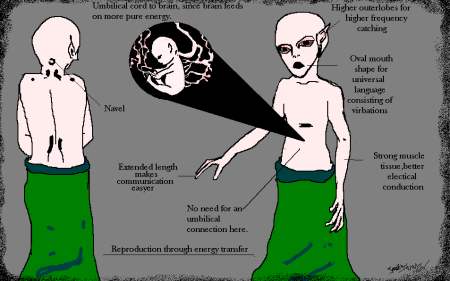
Guest writer Demitrious joins us today to share his ideas.
~~~
I did not write this article to prove to you why the soul exist or dose not, but to connect the dots of genetics and environmental influence of the human brain to the abstract and free flowing beauty of creation.
Do we inhabit a soul? It’s something that many of us ask. Today’s technology has opened up for us some interesting views in exactly how we think, how we operate and why we dream. Many people today are convinced that our personality, are way of viewing the world and our motives are all part of the genetic, environment code we are all born with. That we are nothing more than electrical impulses and synapse firings.
But to really question the soul it takes some reflection on really asking, what makes a “soul”. Is it our personality, our dreams or our secret fantasies? Surly I could say that all those attributes are mere expressions of our environmental, genetic operating. But perhaps the soul isn’t what dreams we do have, our personality or what fantasies we often visualize our self acting out. Perhaps the soul is our instinct. (The way we pick/ single out and organize) It’s the reason we respond the way we do. Perhaps our souls are a connection to the begging of the universes creation, it’s every living particle and pattern ever developed. The soul could be called "the pattern interpreter". Some people believe in reincarnation, the living of another life after death, a non-stopping cycle of experience and touch. This would make some since if we look at our very first expressions after birth. We are not blank slates like John Locke once said. When you where a child, you always had an "opinion", you always had a reaction to experience, and was this genetically hardwired? Is it the infantile amnesia while the unconscious memory of the womb remaining? And what exactly goes on in the womb? Could the earth’s position, the temperature, effect our genetic hardwiring also, I think we need Darwin’s input on the evolution of the being in here as well.
Either way it seems we have always had a self, independent and observant. When can you remember making your first judgment and not just accepting things? Another question some people might ask is “Do animals have souls?" I certainly believe so, and then we might say the soul is not the personality because of our cerebral cortex. Well for those who assume the personality is only experienced through the cerebral cortex has to reflect on memory, because memory alone makes up an enormous part of our "selves" and this is not present in just one of our areas of the brain. Consciousness could be defined the "awareness" of our lives and influences of what pain and pleasure are doing to us. This Consciousness might by some ruling be considered the soul. Separating ourselves from animals, trees and machines we again might use this definition to explain why we are the superior race of the earth. One thing I often contemplate is what if animals, trees, and such are aware of what’s effecting them, but because of genetic material makeup they cannot respond the way we do.
The soul could be that “pattern interpretation” Over many many years we have accumulated through ion to ion, influence of orbit. What if the soul is an effect? Perhaps we do have a Collective Unconscious like Jung Said. And this is the instinct, the evolution through time and space, from form to form, season to season, ect. Humans as an individual are granted a great benefit in having such a brain as we do to expressing our reactions in to the physical world. I see the brain as a wet sponge waiting for an electrical impute to turn it on, When tissue and "soul" unite through years and years of experience they become the very prominent and skilled "us". This soul is the energy, the invisible reactions from the very begging of creation. Like I said before, the instinct we all inhibit deep in our beings could be such a soul. Some people might have a little different instinct, Perhaps they have been "interpreting patterns" a lot longer. In the creation of life something was fueling it, something enormous and skilled, Perhaps it was like water running over rocks making erosion pushing, lifting, sifting, changing the very foundation of life its self. The soul could be known as the water and the body and brain could be called the rock. The water doesn’t change, but it alters the curvature and appearance of the rock, so as the rock and re-direct the flow of the water anyway environment has affected it. This might seem an off way analogy but life is all about analogy’s. Your soul in some ways could be pictures as a frequency wave with crest and troughs showing the very dints and curves your life or life’s have gone through and if this was the case then the "pattern interpreter" makes a lot of since. There’s a lot more to question as to the individual soul and why this seems so. But that’s for later.
-Demetrious
May 10, 2004
Future of Computation is Infinite

Roland Piquepaille's Technology Trends has a new post called Future of Computation Is Finite which discusses the conclusions made by a couple of scientists. I disagree with their conclusions. I think the more likely scenario is there are ultimately no limits to computation at all. But first, here is an excerpt:
According to PhysicsWeb, two cosmologists from Case Western Reserve University have shown that the acceleration of the expansion of our universe leads to physical limits on the total amount of information that can be stored and processed in the future. They also determined a time limit for Moore's law which will still be valid for the next 600 years. Finally, they calculated that the total number of computer bits that could be processed in the future will not exceed the 10120 range. In a previous story, "Universe is a computer," another physicist estimated that the number of calculations the Universe would have performed since the Big Bang -- if it was a computer -- and also came with a 10120 number. I'm not sure if both studies are speaking about the same exact things. But if they are, does this mean that we are exactly at the midlife point of our Universe?
The acceleration of the expansion of the universe places limits on future developments in technology according to two US cosmologists. Lawrence Krauss and Glenn Starkman of Case Western Reserve University have shown that the acceleration could put a fundamental limit on the total amout of information that can be stored and processed in the future. They also calculate that Moore's Law will remain valid for no more than 600 years -- although workers in the semiconductor industry are more pessimistic and think that the famous law will break down in the next decade or two.
They also found other physical limitations.
The duo calculated that the total number of computer bits that could be processed in the future would be less than 1.35120. This means that the effective information available to any observer within the event horizon of an expanding universe will be significantly less than the total so-called Hawking-Beckenstein entropy -- the entropy that is associated with a black hole -- in the universe. Many cosmologists predict that an accelerating universe will ultimately contain nothing but black holes, which will then eventually disappear themselves.
Right or wrong, the physicists seem to enjoy their work.
"It is remarkable that results from cosmology can provide such definite limits on the nature of technology," Krauss told PhysicsWeb. "In addition, it is also remarkable that simple laws of physics put such robust constraints on life, and technology, even when we don't know what that technology will be like."
For more information, the research paper has been published by ArXiv in its astrophysics section under the name "Universal Limits on Computation" on April 26, 2004. Here are the links to the abstract and to the full text (PDF format, 3 pages, 89 KB).
I disagree with these conclusions, and think they are made in part because of a confusion of semantics. For example, as our knoweldge of cosmology increases, we have had to continually revise what we mean when we say universe. The original definition of this word implied everything that is. Now it's quite common for cosmologists to refer to our universe as one among an infinite number of possibilities. Tegmark in last years SciAm introduced to the general public his "ensemble theory" which postulates an infinite number of other universe, not just an infinite number similar to ours but an infinite number of dissimilar universes. Since we are dealing with infinite sets of infinity, we are actually discussing a transinfinite set of universes of every "mathematical" possibility.
So when these scientist above discuss Universal computation, they aren't discussing something truly universal in light of the latest cosmological models. A more accurate way of articulating it might be to say somthing like, "These are the limits of computation as far as we know in our local finite bounded universe."
As I have postulated many times before, all of these predictions about the limits of computation are being devised by 3lb mind-brains on a small rock around an ordinary star. Given sufficient time and intelligence, all such perceived limits will evaporate in the presence of greater intelligence.
For more information on that idea, please read:
Sans-Celing Hypothesis
Apothesosis
Reality 3.0: Hypermediation & Paradise Engineering
May 09, 2004
Common errors in reasoning
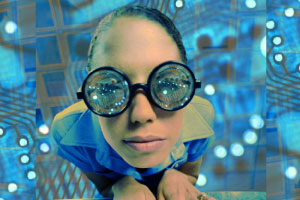 In a comment to a previoius post, Michael Anissimov
mentioned a number of pervasive errors in reasoning that are common to
practically all human beings. Well, I know about that kind of thinking
fallacies, but I didn't know all the "official" terms. In psychological
research, a number of these fallacies have been given names, and been
studied in some depth.
In a comment to a previoius post, Michael Anissimov
mentioned a number of pervasive errors in reasoning that are common to
practically all human beings. Well, I know about that kind of thinking
fallacies, but I didn't know all the "official" terms. In psychological
research, a number of these fallacies have been given names, and been
studied in some depth.
Situations in which people assess the frequency of a class or the probability of an event by the ease with which instances or occurrences can be brought to mind.
People inadvertently assume that readily-available instances, examples or images represent unbiased estimates of statistical probabilities.
E.g. if you've mainly been around a certain type of people, you easily get to believe they represent a typical cross-section of the population. At least, your estimates of various characteristics and beliefs will be biased towards the profile of the people you know. "To a hammer, everything is a nail".
When two events can occur separately or together, the conjunction, where they overlap, cannot be more likely than the likelihood of either of the two individual events. However, people forget this and ascribe a higher likelihood to combination events, erroneously associating quantity of events with quantity of probability.
Here's an example:
Bill is 34 years old. He is intelligent, but unimaginative, compulsive and generally lifeless. In school, he was strong in mathematics but weak in social studies and humanities.
Which statement is more probable:
A. Bill is an accountant that plays jazz for a hobby, or
B. Bill plays jazz for a hobby?
92% of people in a survey answered A. Which is completely wrong. See answer
Research has shown that people find it very difficult to decide what information is necessary in order to test the truth of an abstract logical reasoning problem. The Wason Selection Task is often used to examine this issue.
A typical experiment using the Wason Selection Task will present some rule, and ask subjects to see if the rule is being violated. Consider the rule: If a card has a D on one side, it has a 3 on the other side. Subjects are aware that on the particular set of cards, each one has a letter on one side and a number on the other side. Four cards are shown, such as those below:

Very few people can correctly pick the two cards to turn over to verify the rule. The correct cards are D and 7; most likely, you picked D and 3. Seeing what is on the reverse of the 7 card can lead to falsifying the rule if a D shows up. Seeing what is on the reverse of the 3 card cannot falsify the rule. It can confirm the rule, but not falsify it.
Various theories based on Amos Tversky's research, also related to availability bias, representativeness bias and anchoring.
Support Theory has an empirical base of results showing that different descriptions of the same event often produce different subjective probability estimates. It explains these results in terms of subjective evaluations of supporting evidence. [...]
According to the ‘framing effect’ peoples’ understanding of a problem is profoundly influenced by how the problem is presented.
For example, support for an option seems to increases the more that the option is broken down into smaller components. And naturally, if an option is particularly highlighted (anchored), people would tend to choose that over others, whether it is logical or probable or not.
Another interesting tidbit:
"This framework questioned the assumption of "homo oeconomicus", that is, of human beings motivated by self interest and capable of rational decision making behavior."
Masses of people are so easy to mislead (advertising, politics, media) that there's certainly no guarantee that they'll make rational decisions, which assumption is the basis for our economic system.
People tend to judge the probability of an event by finding a ‘comparable known’ event and assuming that the probabilities will be similar.
As a part of creating meaning from what we experience, we need to classify things. If something does not fit exactly into a known category, we will approximate with the nearest class available.
Overall, the primary fallacy is in assuming that similarity in one aspect leads to similarity in other aspects.
The gambler’s fallacy, the belief in runs of good and bad luck can be explained by the representativeness heuristic.
People will also ‘force’ statistical arrangements to represent their beliefs about them, for example a set of random numbers will be carefully mixed up so no similar numbers are near one another.
Examples:
If I meet someone with a laid back attitude and long hair, I might assume they are Californian, whereas someone who is very polite but rigid may be assumed to be English.
People will often assume that a random sequence in a lottery is more likely than a arithmetic sequence of numbers.
If I meet three people from a company and they are all aggressive, I will assume that the company has an aggressive culture and that most other people from that firm will also be aggressive.
There are a lot more theories and terms and models, of course. See, for example, this list of psychological theories, explained in simple terms.
Obviously, the human mind isn't overly suited for making logical decisions, or for correctly estimating the probability of events. It might seem a bit surprising that we even manage to keep ourselves alive and accomplish complicated technological feats. It explains at least why we often make decisions that don't serve us, and why we easily elect the wrong people to lead us. Of course it helps greatly if we can stay conscious of the various ways we are likely to fool ourselves, so we can avoid them, as much as possible, when we're trying to make important decisions.
And, of course, since we can even study it and talk about it, of course we can also be conscious of it and overcome it to some degree. Is human thinking so unreliable that we would have to develop a Friendly AI who can take over and run things for us so we don't destroy ourselves? Then how on earth can we be trusted to get that done right? It can get a bit circular. What makes the difference is our consciousness, our ability to be aware, also of our own shortcomings.
Related:
Stephen's Guide to Logical Fallacies.
May 08, 2004
What is Natural Selection? A Plea for Clarification
by Neil Broom
Abstract—I argue in this paper that any evolutionary theory of life that excludes from the living world a primary non-material or transcendent dimension or guiding presence, is no theory at all. The materialist's claim that natural selection supplies this evolutionary 'arrow' but is entirely material in its action, is a fundamentally dishonest claim. If there is no real purposive agenda that natural selection is pursuing then the expression "natural selection" is blatantly misleading and should be deleted from the evolutionary vocabulary.
The full paper is available below:
What is Natural Selection? A Plea for Clarification
May 07, 2004
Psychotherapy and Shamanism
From an article by psychedelic pioneer and shamanic anthropologist, Ralph Metzner, titled Hallucinogenic Drugs and Plants in Psychotherapy and Shamanism:
Certain common elements can be found in the anthropological literature on the experiences with hallucinogenic plants in shamanistic indigenous societies. These features are also found in accounts of shamanic journey experiences with other modalities, such as drumming, vision questing, or conscious dreaming. It is clear that these experiential features imply the existence of a radically different worldview (than the Western) in entheogenic shamanic practicioners. I will simply list these features, since there is not the space here to document them extensively.(1) The role of the guide, curandera or healer is always described as central and essential. This must be a person with extensive personal experience in the use of these medicines, who agrees to provide an initiatory experience to a seeker or training to an apprentice. In virtually all entheogenic rituals, the guide or shaman does much or all of the singing, and this singing profoundly shapes the quality and content of the experience.
(2) The experience can be healing, on physical, psychic and spiritual levels (although traditional shamanic healers do not make such analytic distinctions). Shamanic healing experiences, with entheogens or other means, have three main variations: one is the extraction of a toxin, that may have been implanted by means of sorcery; the second is the retrieval of a split-off psychic fragment or "soul"; and the third is the experience of being dismembered or destroyed, and then reconstituted with a healthier, stronger "body."
(3) The experience can provide access to hidden knowledge, -- this is the aspect of divination, "seeing", prophecy, intuition or visioning. If the intention or context is healing, then the divination would be equivalent what Western medicine calls diagnosis -- e.g. from where and from whom did the particular toxic implant come, where has the soul-fragment been "lost", what particular herbs should be used for the person's illness, etc. It is said that there is an intelligence associated with the plant medicine, an intelligence that communicates in an interior way to the person who ingests the medicine. Indigenous healers refer to the entheogenic plants as "plant teachers".
(4) There is a feeling and perception of access to meta-physical realms or worlds. Such realms have, in shamanic, esoteric or magical traditions, been referred to variously as "inner world", "spirit world", "upper or lower world", "faerie world", "dreamtime" or "otherworld". Some anthropologists, including Michael Harner, refer to them as "non-ordinary reality." The access to these other-worlds may come through a kind of journey to that world; perhaps on the back of an animal or carried by a large bird. Alternatively, one may feel that one can see into the spirit world without moving, while still aware of the ordinary present world of time-space as well. Scenery and beings of the other world may appear in our world. In any event, the usual boundaries between the worlds seem to become more permeable, during such experiences.
(5) The experience may involve the perception of non-material, normally invisible, spirit beings or entities. Such spirits are recognized as being associated with particular animals (e.g. serpent, jaguar), certain plants, trees or fungi, certain places (e.g. river, rainforest), deceased ancestors, and other non-ordinary entities (e.g. extra-terrestrials, elves). It can include the experiences of actually becoming or identifying with that spirit (e.g. the experience of becoming a jaguar or a serpent). The healing and divination is experienced as being done by or with the assistance of such spirits, also referred to as "allies", "power animals", "guardians" or "helpers". In some healing rituals, there may also be contact with bad or malevolent spirits, that need to be exorcized or neutralized in some way.
Tribute to John Lilly
Our friends over at Goa)(Gate have written a beuatiful tribute to my personal hero and spiritual father, John Cunningman Lilly.
This contrubution is in Loving Memory of John C. Lilly, M.D.
see also our PhotoBlog album: Grateful Heads - John C. Lilly
NAME: John Cunningham Lilly, B.Sc., M.D.
PARENTS: Richard C. Lilly, Rachel C. Lilly
BIRTH: 0707 hours, 6 January 1915, St. Paul, Minnesota
DEATH: September 30, 2001, Los Angeles, California
As we think that J. C. Lilly - a big brain with heart and huge consciousness - was one of the Grateful-Heads of the last century, we have decided to give some information about his live and further links which can be found in the world wide web. As one may see at John C. Lilly Homepage his live was very colorful and is not easy to summarize. He started his research in the fields of biology and neurology. As he was interested in the human brain and the mind, he was both a scientist and a psychonaut.
John was one pioneer of modern dolphin research and a pathfinder of consciousness research. Thereby his first investigations were supported by the US army. As he was fascinated by his experiences with the “Mind of the Dolphins” he decided to live with and learn from these creatures untill his end of live in 2001. Johns legacy includes, that ”Interspecies Communication” is a realisable feature and that humans do not investigate enough in trying to understand the diversity of consciousness of planet earth.
He was a master in managing the tightrope walk of scientific research and “looking behind” these experiences.
He invented the Samadhi isolation tank technique which led to a special JCL Tank Experiment. John just tried to overcome the so called scientific frontiers and therefore showed that consciousness is present on earth, which does not only refer to humans, but to all the other living species as well. It is difficult to calculate how relevant his work will be for the future of human conciousness and evolution.
His research of interspecies communication with Dolphins is very special - and maybe therefore genius - , but as we fear not so well known, which is in contrast to the work of his friends i.e. Timothy Leary and Albert Hofmann. It is even nearly impossible to get one of his books in the german language these days - so try ebay, perhaps you are lucky…
One last TIPP:
For the ones who are interested in listen to an electronic guitar sound communicating with Dolphins try the Ode to Dolphins - A Jam Between an electric guitarist and at least 300 Pacific white-sided dolphins.For much more information, we strongly recommend to visit one of the links listed above and below (attention: watch out for hidden links on these sides):
Photo - Links:
Dr. John Lilly’s Birthday Party January 6, 2000 Maui, Hawaii
2001 Hawaii Memorial for John C. LillyFurther Links:
Isolation Tank Info: Samadhi Tank Company
John C. Lilly at Wikipedia: http://en.wikipedia.org/wiki/John_C._Lilly
http://www.interspecies.com/
http://www.earthtrust.org/Websites about Dolphins
A Non-Governmental Organisation from Croatia, set up with the intention to carry out scientific research and conservation projects and promote environmental awareness in the Lo¨inj-Cres archipelago, Croatia and Adriatic region as a whole.http://www.blue-world.org
Lee Perry, a good friend of both myself and John Lilly, the mother of the floatation tank business and founder of Samadhi Tank Company called me the day after he died to tell me the news. In 1997 I purchased my first float tank from her, and have quietly run Floating Planet, a floatation tank retreat out of my house. If your in the area and would like to have a free float, just contact me.
May 06, 2004
Milky Way Marmalade
Orange cube of gelatin contains the ultimate knowledge of the universe
I discovered this book and review via Reality Carnival.
An orange cube of gelatin contains the ultimate knowledge of the universe. Called L'Orange, or the Akashic Records, or the Philosopher's Stone, or the Universal Hologram, and so on, it contains the past, present and future of all things. In the year 3265, Trinesmart Quark, II, a "procurer" of exotic foods, travels the universe in pursuit of his trade, until he tires of killing exotics merely for the satisfaction of the extremely wealthy and indulged. Soon he finds himself in pursuit of L'Orange and engaged in a surreal adventure.Floating in the vastness of space, Caffrey discovers an ancient jukebox and recovers the sound of 20th century music. Living in a time when music no longer exists, Caffey finds that rock and roll speaks to his soul. His new passion lends new purpose to his life and he retires from procurement to spend his life on 20th century earth. But soon the android Poe 33, Portsmith to L'Orange finds him and ask for help. Suspiciously separated from L'Orange, Poe 33 needs Quark to help him before another entity can capture L'Orange and gain ultimate domination of the universe.
Author Michael DiCerto pens a novel that combines the outrageous fun of Hitchiker's Guide To The Galaxy and Monty Python with the search for cosmic meaning. Exotic imaginings and bizarre adventure lend Milky Way Marmalade an irresistible appeal with its whimsical and outrageous style. Science fiction fans will discover DiCerto's gift of fabulous characterizations and wicked plotting lends a dynamic freshness to the genre. With rich nuances that become at once spiritual and satirical, Milky Way Marmalade belongs on the keeper shelf. Very highly recommended.
Psychedelic Science Theater
Via Bruce Eisner,
Wandering the web via Google, I came upon Psychedelic Science Theater with a lot of fun games that really work. Turns out, the theater is part of a larger spunky young Brit site called SeethruZine. The site calls itself Your Internet Filter and Webzine. It has a good music section and do not miss the Good Drugs Guide.
The Internet of Things
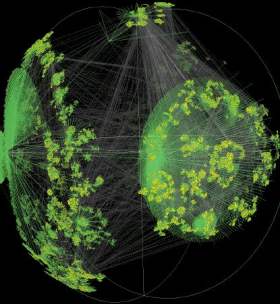
Red Herring Blog: "Disruptive innovations" via Roland Tanglao:
Every few decades a brew of technologies creates the possibility for not just a single disruptive innovation, or a few in an industry, but a wave spread across business, work, and daily life.Connecting all things to all things. And making them smart.The next brew is simmering.
What are the ingredients? Some are familiar: wireless, XML, GPS, mobile devices. Others are less well known, or still struggling to get out of the lab. Smart dust, cubic-centimeter sized computers. MEMS, which gives computers the ability to sense and react to their surroundings. IPv6, which will allow everything to have an IP address. RFID (radio frequency identification) tags, which attach data to objects. Flexible LEDs, printed onto plastic sheets and foldable into origami shapes.
Taken individually, these are novelties. Taken together, they promise to create a profound yet extremely simple phenomenon: the collapse of the boundary between the digital and the physical. In the foreseeable future, cyberspace and real space, the worlds of data and things, will merge. Understand the implications of this merger, and you can better understand how individual technologies – and products that use them – will fare in the future.
We're already seeing the beginnings of that breakdown.
Mobile phones show how addictive constant connectivity can be: there's a reason the Finnish call cell phones kanny, an extension of the hand. Wi-fi hot spots and laptops let us enjoy a still-fractured ubiquity, giving a glimpse of an always-on, always-available Web. (As William Gibson said, the future is here, it's just not evenly distributed. Right now, it has an effective range of about 150 feet.)
RFID, sensors, and smart dust are building intelligence into every manufactured object. GPS has moved from the yachting set to weekend hikers and soccer moms (those little bubbles on the roofs of new cars contain GPS locators).
IPv6, the next-generation Internet protocol, will let stationary objects describe their locations. IPv6-enabled street lamps or traffic signals, for example, could warn utilities when they're about to malfunction; if their Internet addresses were associated with physical locations, they could function as a physical address, letting repairmen pinpoint their locations.
Add it all together, and you get what computer scientists call "the Internet of things." It's a world in which data is part of the world; physical and virtual addresses are associated; things have senses, the ability to communicate, and the capacity to cooperate; and we can create and access information almost anywhere. What happens when computers leave the world, and cyberspace becomes part of it? When we have billions of tiny computers capable of working together? When the Web is experienced not as a separate universe, but an overlay on the world?
We're going to find out.
May 05, 2004
The Self as Metaprogrammer

LVX23 April 2004
The human brain is not a static computing device merely receiving and processing information acquired by its sensoria but, rather, it is a dynamic and plastic network of neural centers, each specialized to handle specific tasks, coordinated with each other through a continuously changing array of associative connections between hundreds of billions of neural cells. (Readers are encouraged to look through "The Self & It's Brain" by Karl Popper & John Eccles for exhaustive studies of neuronal plasticity in associative networks and their implications for consciousness.) While the various regions of the brain are shared by all humans, and the functions of those regions are essentially the same in each of us, the connections between them and the intangible interface which integrates experience between our senses and our mind is absolutely unique to each individual. Genetic predisposition, early imprints, and life experiences each contribute to the ever-evolving construct of the individual. And behind it all in the secret center of our mind, resides the self, absolutely intangible but undeniably real, stringing together the momentary snapshots of the sensoria, creating our sense of time and guiding the processes of mind in accord with its will. But while many may never question the way their mind and brain color their world, others seek to elevate the self to the level of meta-programmer and actively break the bonds of belief to rewire the associative network of the brain and its mind. Many tools exist for such a task, including the archaic techniques of shamanism, the use of psychedelic compounds, and the canon of western esoterica commonly known as magick. By employing these and other methods it is possible to directly modify the physiology of the brain and reprogram the mind in accord with the ideals of the self. (Please note that this paper is not intended to present a reductionist or mechanistic view of consciousness. The visionary experiences of shamanism and the phenomenology of magick are far more profound and ineffable than if they were simply side effects of metabolism.)
Neuropsychology - the physiology of mind
The human brain is exceedingly complex. We know much about it, but what we know is very little compared to what we don't know. The mind is far more amorphous and slippery, often evading attempts by science to pin it down. Indeed, most neuroscientists adhere to the convenient convention of never addressing consciousness because it always confounds the data. Or rather, it usually fails to generate consistent, reproducible results. The mind remains the domain of psychology, philosophy, and metaphysics. Yet even more elusive and intangible is the vague concept of "the self".
The self is like the secret chief of the sentient human. It is the innermost core of the self-conscious mind - the impulse behind the thought to move one's arm. Like some discarnate analyst, the self watches the roiling surface of mind, focusing its attention on what it reads from the immense neural activity of the brain. In this manner it filters the flood of data to focus on what it needs to satisfy its intention. Moment to moment the self takes filtered snapshots of the brain, stringing them together into the perception of time seemingly unique to humans. The experience of time then is like watching a movie of the brain's electromagnetic processes. The self gives us identity and history, as well as the capacity to plan for and predict the future. While it remains ultimately indefinable and, at its core, may be completely without substance or dimension, our common experience of the self is one of concrete identity, wrapped in our mental clothing and bound to the physiology of our corporeal incarnation.
For humans, uniqueness is not merely the phenotypic expression of their DNA. Our physical appearance is indeed a unique identifier for just about all of us, but what really makes us who we are, what defines the self of each individual, is the mind. We are each an impossibly unique summation of biology, environment, experience, chance & circumstance defining the physiology of our brains and the topology of our mental processes. We have thoughts & memories, beliefs, dreams, chemical signatures and genetic predispositions among a myriad of other complex influences. In the spirit of convenience, we can define these influences by 3 levels: the genetic, the imprint, and the experiential.
At the genetic level, genes predetermine the physical structure and underlying metabolism of neural centers. Thus, one person may have an overactive hypothalamus, another a deficiency of serotonin, and a third an extra sensitive limbic system. Such structural differences could also have been the result of inappropriate diet or exposure to toxins in the formative years of infancy or, earlier, in the womb passed from the habits or oversights of the mother. But the physiology of the individual is the foundation of everything else and any variations will establish a unique template upon which the self is constructed. The next level could be regarded as the imprint level - the very early experiences of infancy such as the degree of physical love given by the parents, experiences to which the child was exposed, and the types of symbols and tools introduced into its world. The bridge between this layer and the experiential layer is language, which, once acquired, will radically alter the way the mind interfaces with the world. The experiential level is formed by the accumulation of life experiences as perceived and classified by the person as they grow and live. This level is perhaps the most intangible and convoluted as it is informed by the genetic and imprint levels, as well as the ongoing feedback loop of experience. These factors ensure that life for one will never be identical to another. For example, the same event may be perceived very differently by someone with a genetic chemical deficiency, an unloving parent, and a past characterized by abuse than by someone with a relatively standard psychogenetic profile. Similarly, someone with a typical genome and caring parents could gradually be changed from a playful & cheery child into a cold and lonely adult depending upon the types of associations made within their brain as they respond to the circumstances of life. The person could witness the brutal death of the loving parent and re-associate that love with suffering and loss. In an instant their world might change from a kind and happy place to one of loneliness and darkness as the brain rewires itself to cope with the tragedy of loss.
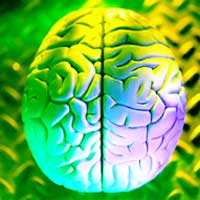
The Brain
The brain is a collection of neuronal bundles - groups of cells differentiated to handle specific aspects of neural processing. The cerebellum regulates autonomic functions like the beating of the heart and respiration. The thalamus is the master controller for the body's hormonal network. The occipital lobe processes visual information while the temporal lobe houses the speech and language centers. The hippocampus stores and retrieves memory and the limbic system adds emotional content to everything. As previously stated each of the bodies within the brain is present in every person, though they often differ in physiology to some degree. But more important to the uniqueness of the self are the connections between these bodies and the way that experiences move within the brain and are colored by each processor.
Microscopic pictures of the brain, particularly clumps of brain cells, reveal a ridiculous organic mess akin to a plate of spaghetti tumbled in a washing machine. This wild disorder is testament to the plasticity of brain cells: they are constantly making new connections with other cells, terminating old connections, and even arcing back on themselves. A single neuron may make over a thousand connections. Indeed, in a mass of 100 billion neurons the number of possible connections between them is more than the number of atoms in the known universe. This is how the human brain is so incredibly capable of dealing with amazingly complex situations and calculations: it is constantly rewiring itself to make new connections, to update its hardware to better adapt to and solve novel situations and problems.
Mind
The complexity of the brain grows exponentially when we place mind as the mediator between experience and neurophysiology. If the brain is the product of genetics, imprints, and experiences, then so too is the mind. Mind and its psychological complexes - such as Freud's psyche and Jung's collective unconsciousness, our identity and beliefs, as well as our plans, goals, and dreams - is a dynamic evolving construct informed by every facet of our existence. As a perceiving, self-aware organism we channel all the information of our senses through the brain and into the evaluative processes of the mind. Mind is the operating system running on the hardware of the brain. But unlike silicon computers, the software of the mind alters the hardware of the brain. Experience and how it is received by the individual determines the evolving structure within neural bodies, as well as the associative connections made between them. Mind is like an abstraction layer sitting on top of the electromagnetic fields generated by the brain's neurochemistry. The mind is focused to sift through the vast amount of data generated by neural processes, evaluating and cataloging that data and picking out the bits that it deems important to the current situation or query. This disembodied aetheric wave then enacts its will upon the physiology of the brain, modifying the chemistry and physiology of the neural substrate in accord with its goals. It can be as simple as moving the arm, or as complex as composing a symphony. This is how the adaptive computational abilities of the mind grow in response to the world in which the organism is embedded. We analyze the data, consider a response, extrapolate the results into various models and outcomes, and then induce the body to action. The outcome of the action is then recorded and compared to the projected models. As this process repeats, learning occurs and the associative connections - the physical nerve fibers arcing between various bodies of the brain - are strengthened.
The initial perception of fire is one of color, warmth, awe, and wonder. Touch it and those associations quickly change to include pain and damage to the organism. With the shock of sudden pain the internal representation of "fire" has been modified and updated to better fit the external experience. Not only does the brain now include pain in its internal representation, but also a host of emotional content relative to the experience. Did Mom tell you to stay away from the fire but you disobeyed and touched it anyway? Desire, embarrassment, betrayal by the warm colors, fear - for humans, associating emotional content with an experience is like a tag which makes memories stronger and more readily retrievable, better enabling the individual to deal with the world.
Emotional associations are strong defining features of the individual. They determine how we react to people, places, events, colors, sounds, everything. Even to our own thoughts, our own physiology. They are the lenses through which we view the world. The critical point to understand with respect to our thesis is that these associations are rooted in physiology and are not static. They can be willfully modified and changed, affecting the actual physiology of the brain by modifying connections within and between neural bodies. We are programmable. We are constantly being programmed every day by our perceptions, our experiences, what we eat and drink, our music, our movies and television, the people we encounter, even a single word or symbol has the capacity to affect physiological change deep within our brains, subtly altering the associative network of consciousness. Indeed, language (as we will discuss later) is perhaps the most powerful program we know.
Metaprogramming - becoming the mind you want to be
Most of us will live our lives without much consideration of these ideas, content to exist as semi-automatons, acting & reacting based on genetics and imprints and the accumulated experiences of our lives without ever questioning these habitual responses to our world. In spite of the brain's ongoing updates, the perceptions and beliefs of most people will change little after about 30 years of age, barring some sudden traumatic or visionary experience which disrupts their ingrained view of things enough to allow the brain to rewire a new way of seeing the world. Yet the hardware of the brain and the software of the mind is open source. We can each become mind programmers - metaprogrammers - actively rewiring our beliefs and associations towards whatever goal we may have. This is no new revelation and there are many techniques, both modern and archaic, for breaking the mold of belief and mapping novel associations in the brain.
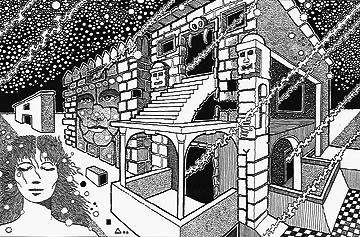
Shamanism
Shamanism is perhaps a good starting point. Shamen have been subjecting the brain to physical and chemical stressors for millennia, seeking to shatter the boundaries of knowledge and walk between the worlds of the real and imagined. If anything can be said about reality, it's that it only exists in the eye of the beholder. Or rather, behind the eye in the depths of the brain and its mind. The slightest modulation of chemistry will radically alter one's "reality", like the onset of schizophrenia or 150mcg of lysergic acid diethylamide. The shaman understands this malleability of reality and seeks to use it to hir advantage. Trance, dance, pain, hallucinogenic plants, fasting - all of these things can radically alter human physiology. The substrate of mind changes and the shaman's perception of reality is altered allowing hir to view the world through different lenses, to see formerly hidden aspects of self and nature. It's like suddenly having bee vision. Bees are known to see the 3-color RGB spectrum like humans, but they can also see into the ultraviolet bands. Many flowers have special markings only visible in the UV spectrum to attract bees who will then aid in cross-pollination of the flowers. So humans only perceive a specific region of nature, adapted as it is to their unique brand of evolutionary survival. This observable bandwidth is further narrowed by our conditioned beliefs and imposed expectations of what is acceptable data. The shaman seeks to widen the perceptual bandwidth and retrain the mind to see more levels of reality.
To return to our notion of the self as a discarnate interpreter and integrator of complex neurological processes, the effect of shamanic techniques is to present that self with a novel set of data in an attempt to break up the crust of belief that limits the accepted notions of how things ought to be. Although the self is not entirely bound by physiology it nevertheless has a tendency to become rigid and narrow in its conceptual map of how reality should behave, due in large part to the strength of the ego - the ultimate abstraction of the biosurvival mechanism inherent in all creatures. The narrowing of focus establishing the boundaries of the self and its world is strengthened by a feedback loop between the logical and emotional constructs of the mind and the physiological substrate of those constructs as they exist in the brain. The mind, it seems, seeks stability. It seeks order and, most importantly, predictability. We are, after all, organisms trying to survive in a potentially hostile environment so it is a beneficial and adaptive mechanism to create functionally accurate & static maps of the world. As we move through our lives our maps, our expectations, our ingrained responses to events and situations, images and ideas, become more defined and concrete. The human mind wears its belief systems as armor and the techniques of shamanism are ways of breaking through that armor by eroding the fundamental expectations of reality as defined by our beliefs.
Psychedelics
Perhaps the most powerful technique originally pioneered by archaic shamen is the ingestion of psychotropic agents – the "mind manifesting" psychedelics. No other technique short of the experience of near-death seems to work with the same efficacy as psychedelic compounds. These unique molecules, originally produced by plants for some as-of-yet unknown evolutionary function, induce changes in brain chemistry by binding to and modulating the activity of neurons in neural controller bodies like the reticular activating system. These changes in chemistry have profound effects on higher brain centers radically altering the pattern of data presented to the mind. Increased activity in the occipital cortex induces visual hallucinations, sounds take on new depth, the boundaries of self begin to dissolve as the emotive centers become unleashed imbuing the perceived world with a rich depth of meaning and emotion. The initial shock of seeing the world in such a different way can be enough to undermine the currently held belief system with the basic understanding that the world as we normally perceive it is far more rich and malleable than we had thought. The associative network of the brain shudders and can enter a state of uncertainty as the mind attempts to make sense of the visions. It is in this state that it is possible for the self to reprogram those networks, as if the drug were a passkey granting access to the mainframe of the brain.
John Lilly has written much of this ability of psychedelics to induce flexibility in the mind, coining the term "metaprogramming". Timothy Leary, Robert Anton Wilson, Alexander Shulgin, and other hallucinogenic visionaries & therapists have honored this ability of psychedelics to launch the user into a state of psychological malleability. Indeed, the U.S. investigated these substances as potential mind control agents in the MKULTRA and ARTICHOKE projects but found that they were too unwieldy, and the subjects difficult to control. These diverse agents seem to be keys that induce specific neurochemical profiles like software programs. The program of LSD is unique from the program for Psilocybin which is itself different from DMT. But they all share the common ability to dilute the ego, break down the beliefs held by the mind, and open the brain to potential reprogramming by the self.
Magick
But it’s not enough to simply shake up the physiological foundations of the brain and open the mind to whatever happens to be floating by. Indeed, it can be very dangerous to do so. As shamanism offers a wealth of cultural myths to guide the shaman and give meaning to hir visions, so to does the rich collection of myths, symbols, deities & entities, rites & rituals, commonly known as Magick. For the sake of this discussion the ability of magick to affect the material world will not be addressed here. An entire volume could and has been written on the subject and it remains as elusive as ever. Instead we will focus on the role of magick as a process of self-actualization through the invocation of god forms, mythologies, and symbolism designed to empower the self with the will necessary to reimagine and remodel the individual according to their ideals. As a model, magick is open-ended and encompasses any technique, including the one's we've already discussed, that is useful for transforming the individual. The key is that magick proceeds by will - we are in charge of ourselves and have the capacity to actualize our visions of who we wish to become. As noted, the trick is putting the brain into such a state that it is open to the change.
The canon of western esoterica has contributed the most to the field of magick. Hermetica, Kabbala & Judaica, Egyptian mythology, The Old Testament, Greek & Roman, Norse & Celtic, all western mythologies have contributed in one way or another. In the last century or so, thanks in large part to the work of Aleister Crowley, magick has expanded to include many of the techniques of the eastern path, such as yoga and meditation, and the modern techniques of Chaos Magick have extended the canon even further to include just about anything. But the core of the western path is represented by Alexandria. It was here that the confluence of the Egyptian, Christian, and Judaic schools met and established the Hermetic Philosophy. This foundation established the principle deities, the descriptions of god, and the rites and rituals used to speak with them. These deities were representations of the aspects of external nature and the internal voices solidifying into the elements of the young human psyche. The gods were anthropomorphic embodiments of life's rich collage, and they would avail themselves to their worshippers given the appropriate conjurations and rites. These humanized archetypes offered a way to understand the mysteries of creation and to integrate their secrets into the individual. The stories of their lives and deaths were like plays written about the trials of life and the mysteries hidden within. The myths offered guidance and meaning for a world destined to grow more and more logical under the weight of language and economics.
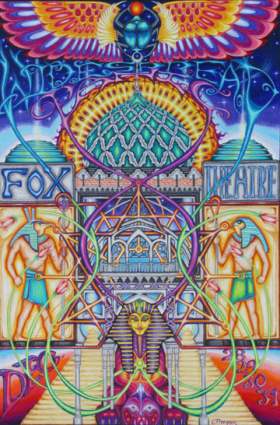
Mythology
While myths like the resurrection of Christ or the dismemberment of Osiris offered keys to the processes of life, death, and rebirth, the gods themselves embodied archetypes of nature and consciousness that could be invoked into being. The real value of the goddess Isis, whether or not she actually exists in some form, is in the archetype of the earthly mother that she embodies. Invoking her essence - running the program Isis - allows us to understand the archetype of female creator and relate it to ourselves as humans. We feel motherhood, earth, water, womb, form applied to force to create being. We understand the balance of Isis and her husband Osiris as the balance of goddess and god, female & male, form & force - subtle universal concepts sometimes difficult to grasp without this anthropomorphic key. The deities of myth embody universal concepts and the stories in which they appear give us paths by which to engage those concepts and transform ourselves by their integration. We become Isis walking along the Nile trying to find the pieces of her dead husband, Osiris, to bring him back from the grave. The myth of resurrection shows that, out of the ashes we can rebuild ourselves anew in the image of the transcendent gods.
This concept of the resurrection, perhaps best symbolized by the phoenix, is a key to our understanding of magick as a tool to reprogramming the mind and brain. The phoenix is a bird engulfed in fire that rises from the ashes aflame, speaking to the notion of death preceding rebirth. As in the shamanic path and the use of psychedelics, the crust of the psyche and the rigidity of the brain's associative networks must be confronted and challenged, torched and torn down to be rebuilt in the new image. The myths and rituals of magick offer paths to tear down the edifice, and the gods and goddesses act as role models to guide the reconstruction.
Ritual
The networks of the brain are not designed to change at the slightest whim or passing fancy. Nor are the constructs of the psyche. Sudden, radical confrontation can inspire change, as in our phoenix analogy, but so can persistent repetition, like learning to play the piano. We acquire this skill through diligent practice, over and over, slowly rewiring our brain to adapt to the task and integrate the art. Much of eastern mysticism proceeds by this path, like a river slowly wearing down the hardened stone until it is soft and polished. Magickal ritual may employ radical initiations, but for most it is a daily practice that gradually reprograms the practitioner to be more in line with the metaphysics of the path. Anything done regularly and consistently will forge grooves in the brain.
A classic example of a ritual recommended to any serious student of magick is the Lesser Ritual of the Pentagram. This practice seeks to bring the student into a magickal space by visualizing key metaphysical concepts like the four cardinal directions, the four elements, the symbolism of the pentagram and hexagram, angelic watchtowers, and the notion of creating a protective space within which one can safely engage higher archetypes. Thus, by daily regimen the aspirant becomes more in tune with these concepts, reassociating their worldview to include the magickal and the divine. To return to our meta-programming metaphor, the Ritual of the Pentagram is like a software application running in the OS of the mind. Initially it must be launched by the user every time but gradually, as it modifies the associative networks of the brain to integrate its code, it begins to act like an agent always running in the background re-enforcing itself in everyday consciousness. The program becomes part of the operating system and even part of the hardware.
Language
Inherent in ritual are language and symbolism. Language is the most defining feature of humanity. All else proceeds from our internal symbolic representations of the world. Our language defines our reality, replacing the awed wonder of childhood with the consensual definitions of the culture. Language allows us to analyze and catalog our environment, and to plan and communicate our intentions – it is the code of mind. When we think, we think in words. The words we chose not only reflect the state of our minds, but they affect it as well. Willingly think dark thoughts and your emotions will darken. Words are very powerful – far more so than we realize – and magickal practice can reawaken the individual to the power of words and languages and the symbols that seek to go beyond their limitations.
Language is the interface between reality and mind. It imposes the
order of definition on a wholly chaotic mess of inherently random
stimuli and, in doing so, ascribes meaning to life. The techniques of
magick can empower the words we use by reminding us of their role in
programming mind. They can also lead us into new or archaic magickal
alphabets laden with rich meaning, which may be lacking in our native
tongue. English particularly is a very rational and logical language
adept at describing physical systems but not so good at describing
emotional abstractions such as love. The role of the poet is to bring
art and emotion into the language and adapt it to speak of the
ineffable. In this manner a profound poem is more than simply the words
of which it is composed. The arrangement of the language becomes a
transformational vehicle into the subtle realms of the human
experience, normally indescribable by words alone. It is thus apparent
that the poet and the mage have a common goal: to sidestep the
boundaries of language and logic, tap in to the deeper realms of the
human experience, and to return and convey these experiences to the
world.
Obviously language offers many possibilities to the metaprogrammer.
Reading transformational poetry and literature can affect the mind in
pronounced ways. Repetition of words or phrases, engaging specific
words and examining their linguistic content and baggage, or changing
the way you speak, such as eliminating prepositions, can each alter the
way the world and self are perceived. Integrating and speaking in a
foreign language can create a very different way of perceiving the
world, as the rules governing the linguistic interface are different
for each language. Indeed, language is deeply interwoven with culture
and geography and each language creates a unique relational map of the
world. Consider the underlying logical differences between a Latin
alphanumeric language like English and a symbolic character language
like Chinese. The mind using one to represent the world is very
different from the mind using the other, especially given the
historical weight of an ancient language like Chinese.
Ancient languages are common foundations for the esoteric schools. The strongest spiritual systems on the planet are those based on ancient languages such as Hebrew, Arabic, & Sanskrit. Each of these languages created the mindsets of the individuals who contributed the religious myths, and each myth is reflective of the linguistic character through which it was created. And not only do languages create the interface between mind and matter, but the tonal characteristics of the words affects the physiological properties of the person speaking. The intonations of Hebrew god names, for instance, invoke the characteristics of the deity and create a specific sonic resonance within the skull based on the phonetics of the word. These resonances create waves which modify the electromagnetic field of the brain, altering the substrate of mind. In this manner not only are the mythic traits of the deity invoked, but the feeling of the deity is conveyed through the timbre and resonance of the spoken name. This is the basis of the mantra.
Mantra
Mantra is traditionally an eastern creation but it applies well to magick as a metaprogramming technique and is often integrated into western approaches to spirituality. As we’ve seen, words not only hold a definition, but also a sonic signature that resonates through the skull. The mantra capitalizes on both of these features to create meaningful phrases designed to alter brain chemistry and reprogram mind. The classic Tibetan mantra “Om Mane Padme Hum” translates roughly into “I am the jewel in the thousand-petaled lotus of the heart of Shiva”. The definition of the mantra is the linguistic code to be run in the mind. We understand and embrace its meaning and use this as the conscious relationship to the mantra. It means something significant to us and embodies a mystical experience we wish to embrace and integrate. Likewise the words have a distinct phonic signature when spoken. Through repetition the logical definition of the mantra recedes into the subconscious, put to sleep by the gentle cadence and resonance field of its vocalization. Om Mane Padme Hum Om Mane Padme Hum Om Mane Padme Hum. This fragment of code, repeated over and over, calms the torrent of mind and synchronizes the electromagnetic fields of the brain. In this receptive state the meaning of the mantra is internalized, planting seeds of change deep within the subconscious, and deeper within the associative networks of the brain. As the individual returns to baseline consciousness and goes on about their day, the seed germinates. With steady practice, as in the Ritual of the Pentagram, the seed is nourished and grows to affect real change in the consciousness of the individual.
Symbols & Sigils
As we’ve noted language is a very strong force binding us to our cultured perceptions of reality, dominating the internal landscape of mind, so much so that it can become an obstacle to the goals of the metaprogrammer. Logic and rationality, it seems, serve more to re-enforce our conditioned beliefs than allow us to bypass them and change their foundations. The efficacy of foreign languages like Hebrew or Tibetan (foreign to us Anglo devils) is that they lack such rigid definitions as the English tongue. At best we have a translation but in the practice of mantra, the logical meaning of the words must be worn down so that the essence can slip past the constructs of the conscious mind and be embraced by the subconscious. To this end symbolic representation of archetypes, spiritual ideals, personal goals, or any other concept valuable to the metaprogrammer can circumvent the limiting definitions of language and rationality to affect the nonrational layers of the subconscious. Indeed, symbolic representation preceded language and was its precursor, language being the codification of symbolism. It is very old and a very deep and fundamental part of human consciousness. Because symbolism is not restrained by the definitions of language it has been the repository of the ephemeral and indefinable traits of the human experience, particularly emotional and visionary experiences - deeper aspects of the human experience which do not lend themselves well to language.
Though language and symbolism may seem somewhat at odds, Austin Osman Spare created a magickal technique for uniting the two. The intentions and goals of the individual are generally formulated through language, spoken internally in the dialog of the self and its brain. We imagine that we wish to be more disciplined at the gym, for instance, and plan a logical course of action to accomplish this goal. What Spare created was a way to translate the logical conscious intent of the individual into a symbolic subconscious representation: The sigil. A sigil is a symbolic representation of a written intention. “It is my will to be more disciplined at the gym” - a simple metaprogram which can meet much resistance when run in the conscious mind (I’ll do it tomorrow, I’m tired, I have a meeting later, etc…). By isolating the unique consonants of the written intent and rearranging them in a symbolic fashion bearing no coherent resemblance to the words, the intention is encrypted in a visual package designed to fool the conscious mind and slip into the subconscious. Spare postulated many ecstatic techniques, some of which we have discussed here already, for putting the brain into a receptive state. His favorites, probably quite telling of his disposition, were death postures and orgasm. The point is that at the moment of peak exstasis, when the brain has all but shed it’s mind entirely, and the boundaries of the self are shattered in a great limbic shiver, the sigil is stared at and absorbed in 100% concentration. The steady state of the brain is disrupted, the conscious mind is beaten into submission, and the self injects the symbolic intent – the metaprogram – into the subconscious where it can readily rewire the associative networks of the brain.
Symbol, language, myth & ritual - invoked and repeated - form the foundation of the western approach to magick. The process is by no means instantaneous, though shocks and traumas can suddenly jar the individual into a state of gnosis or illumination, but is rather an ongoing path of practice and dedication; an open willingness to give oneself to the higher forms and constructs in hopes that they may become part of the aspirant. It is a process of internalizing and integrating the human maps of spirit and soul, invoking and becoming the idealized god forms of our myths. In doing so, our language takes on new meaning and depth, our mental constructs expand to include the subtle aspects of nature and metaphysics, and the associative networks of the brain change to re-enforce the new mode of behavior.
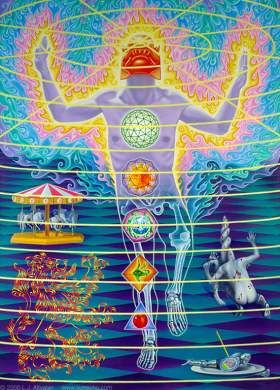
Mind, Matter, & Magick
It is difficult to discuss the profound metaphysical experiences encountered within shamanic, psychedelic, and magickal practice within the context of neurochemistry without sounding mechanistic. While we can attempt to show some of the physiological processes that underlie such experiences, we can never rely solely on chemistry to explain the depth of these visions and the bizarre synchronicities and seeming violations of physical law that so often attend mystical states of consciousness. Suffice it to say that there appears to be much more going on than we suppose and the boundaries between what we imagine to be “reality”, the mind we use to interact with it, and the individual self that guides us through it all, is likely very thin and tenuous, if real at all. At best, reality is an ever-shifting map of language, emotion, associations, and chemistry, unique to every sensory apparatus in the universe. We each look at creation through our own facet of a single infinitely vast diamond, and the world may simply be the result of this infinitude of observation, nonexistent without consciousness. The only thing that is really real to us right now is what’s going on in our own heads.
In this context we can modify our world on two fronts: physical and mental. Trance, drugs, foods, exertion, breathing, and many other techniques offer ways to alter neurochemistry. By changing the chemistry we change the substrate of mind. Similarly, magick, mythology, language, mantra, symbolism, and sigils, among others, can each affect mental states and influence the associative networks of the brain. The personal goal is to employ these techniques to reprogram the brain in accordance with the will of the self, but the outcome is often far greater. As we embark upon a mystical path and engage the archetypes and mythologies of the spirit, we integrate those ideals bringing them to life through our own actions as individuals. As we work with the rituals and symbols, the god-forms and holy languages, we are drawing spirit into the material world by preserving their teachings, evolving their meaning, and strengthening their ability to engage the human soul.
Metaprogramming offers the individual an opportunity to bring themselves into alignment with myths, philosophies, and archetypes, and integrate the characteristics they wish to be part of themselves. The tools available enable us to break down our conditioning and open our awareness to much more of the world than we are ordinarily allowed to see. In doing so we open the mind to new ways of thinking and perceiving, and encourage the brain to integrate these novel perceptions into its physiology.
The metaprogrammer aims ultimately to effect external change from within, in a sort of meta-metaprogram. (This is the other half of this paper that we’ve chosen to set aside as it would easily double the current length.) Suffice it to say that the magick practiced by an individual does not occur in a vacuum, and the assumed lines of boundary between us and everything else are mere illusion. In a vast field of electromagnetic waves with far more space than matter our flesh is only slightly denser than the air we breathe. The fields of the self & its brain are not confined to the skull and, when focused & amplified by the appropriate set of conditions, can influence the dynamic interference pattern that is existence. Like the macroscopic butterfly effect providing the initial impulse at just the right time to be swept along and iterated into the cyclone, focused ritual can have subtly profound influences on the fields of life and consciousness. In this way the metaprogrammer wields a power of potentially great magnitude and is thus not only responsible for themselves but for the entire web of life.
Human consciousness is the product of evolution and the form it has now is very different from that of 200, 1000, or 50000 years ago. Our minds, our language, and the technologies we produce are intimately bound to one another, progressing in a continual feedback loop as each empowers and limits the other. In the modern age we have seen the mechanism and duality of Descartes and Newton supplanted by relativism and quantum uncertainty. We have broken open the atomic nucleus and harnessed the primal powers within to assemble molecules and destroy nations. We have established a planetary network of communication and information, a digital hive mind archiving culture and extending technology through the global brain. And in making information digital we have produced a simulacrum of reality entirely convincing yet entirely malleable, much like the linguistic maps of belief woven within our minds. When it is impossible to tell the real image from the manufactured image, when the fantasy of myth is brought to life in digital cinema, when information technologies can synthesize anything, then the lines between the real and imagined will have grown very thin indeed. Slowly, the human mind and its culture are inexorably drawing nearer and nearer to a time when imagination is as real as anything else and belief is a faint vestige of the past.
The shaman, the psychonaut, and the metaprogrammer have intuited this inevitability and are setting themselves ahead of the curve. They engage imagination and invoke it into being, shaping mind and matter in the image of heaven. The central goal of the western magickal paradigm is to unite spirit and matter, the macrocosm and the microcosm - to reveal the kingdom of heaven on Earth. We are becoming the gods and goddesses of antiquity, poised on the edge of time, a breath away from hyperspace.
May 03, 2004
Living Off-Grid Mentally, Physically, Spiritually, Linguistically...
Phil Dhingra, is the author of the very engaging Philosophistry blog. He joins us to share his ideas on the potential of radical independence.
~~~
What are the pros and cons of living off-grid? By living off-grid, I don't just mean living off the electrical grid. I mean off-grid in the sense of having opinions completely non-mainstream, believing in unpopular religious perspectives, subscribing to alternative arts, speaking a different language, living away from large cities, taking non-traditional jobs, and dropping out of school.
It's hard to identify the pros and cons, but I want to explore the various ways in which we can be off-grid.
One of the most novel ways is being agenetic. Ultimately our genes created this machine with some sort of "design" in mind, particularly to be the vehicle for duplicating DNA into our progeny. However, what if you circumvented that design? You could choose not to marry or have kids. That would be the simplest defiance. You could go even further, for example, by not catering to your self-interest, or not getting jealous, or not subconsciously manipulating others through emotional back-n'-forth. Transcending genetics is in a large part transcending emotion.
Utimately you cannot transcend all emotional causes. Some emotion is indeed drawing you to seek transcendence. However, your emotional desire for transcendence was probably meant as a method of obtaining new knowledge, not as a way to avoid the ultimate genetic design.
You could have chosen as a child not to learn the language of your parents. You could try to seek a truly independent, natural, and pure form of communication.
Using the off-grid measure is a new way of looking at ourselves. Rather than calling this person an "independent" person or a "dependent" person, we should analyze to what degrees and in what areas is this person consciously or unconsciously living off-grid. What aspects of being off-grid are morally correct? How is morality merely a matter of just swimming mainstream?
For example, I am off-grid religiously simply because the concepts violate what I believe. However, I'm strongly on-grid when it comes to education and the career-ist life; I have stuck with schooling through the end of college. I'm also on-grid morality-wise as I naturally follow the golden rule: do unto others as they do unto you.
What are the benefits of being on or off grid? What are the genetic underpinnings of a desire to relate to the mainstream or average in varying ways?
To what extent are we naturally chained to the mainstream that is completely inescapable? I didn't choose to speak English, I didn't choose to graduate from High School, nor did I choose to have an eclectic worldview. Those were all chosen by my parents. But my parents didn't really choose, but rather they too were emotionally trapped by a guilt that if they didn't give me those things they would be cutting me short. Imagine how much of a sin it would be not to teach your children a language or to deny them from schooling? why? See, there is a compellation that the "grid" makes you feel right and wrong automatically without a coherent rational analysis.
And it's this grid-based computing that is the essence of the
cultural revolution in humans. You can call it grid-based, or memetics,
or whatever. It's a matter of coupled oscillation and synchrony that
provides much of the substance of style of living.
The Dreaming Universe
I've been reading Daniel Pinchbeck's excellent psychedelic travelogue Breaking Open The Head and one of the most profound realizations of his experiences is the depth and reality of the spirit world and the beings which live in the interstices between mundane life and the subtle dimensions of dream and vision. From the machine elves of DMT to the "heavenly ones" of ayahuasca, the ancestors of eboga and the mushroom people of amanita, the plant psychedelics seem to show the vast terrestrial and extra-terrestrial intelligences present throughout nature, like a waking dreamworld shut off by the human species' deadly insistence upon scientific rationality and numeric evidence. This dreamworld seems to be a very real place, and its star-lit landscapes home to many forces.
This morning my sleep found me in contact with some such force or spirit. The realms of dreams and the psychedelic experience are kindred and tap into the same continuous landscape of spirit and imagination. Within this place arise archetypes and patterns, as well as apparently sentient entities common to many visionary experiences and often bound in some familiar way to the agent of invocation. Elvish or alien beings, for instance, are a common experience of those who blast into the DMT space, lending a consistency and presence to their fundamental existence beyond mere hallucination. Similarly, in tracking my dreams I've realized an interior map of places I commonly visit. A rocky coastline, a large grocery store, an apartment complex - these among others recur in my dreams, uniquely altered in each, but consistent as ideals. I've been mapping this internal geography, and in perceiving this fundamental pattern my dreamscape seems to exist regardless of whether or not I'm dreaming.
This morning I met a man of sickly ochre pallor, skin like wet plastic, aged and sharpened yellow teeth. His black eyes captured my gaze as I stared, both mesmerized and appalled by his visage. I couldn't help but marvel at how unusual and menacing he looked. He was trying to convince me of something and it made me uncomfortable. I left only to be pursued by a black-hooded figure in tattered rags, faceless and riding a bicycle. As it neared me I could feel a tangible presence drawing close to my flesh. I tried to maneuver away but my movements became sluggish and labored as the entity circled around to confront me. Shaking and afraid I jacked out and awoke.
The most striking aspect of this dream to me is its uniqueness. I rarely have dreams where I become scared. Usually my dreams are light adventures where I float through them feeling strong and in control. Furthermore I rarely ever meet such dark and menacing characters. The tangibility of fear was the element which lent the most realism to the experience and made me consider its depth. If I adopt Pinchbeck's realization - which I am inclined to do as it resonates much with my own experiences - then I met a malevolent entity of some power intruding on my dream, manifest as the ochre man then as the black-hooded bicyclist. Perhaps I met a demon, or a dark archetype (they are the same, after all) feeding off of my fear. An Archon.
Questions of course arise, least of which would probably concern the reality of this dream and the sanity of the dreamer. What did this entity want? What was the source of my fear? More importantly, what does the vision mean to me? And this is the central crux of the issue and the fundamental element which separates the mystical path from that of rationalism: Meaning. Science and rationalism have stripped meaning from life in favor of material evidence. Mysticism seeks to balance the world of materialism with the world of imagination. Or, more correctly, mysticism seeks to bring spirit into matter to awaken the dreaming universe to its own lucid glory. The kingdom of heaven is on earth. Creation is the dream of god and we are all sleepers.
Shaffer Psychedelic Library
The Drug War Chronicle hosts a good selection of full psychedelic texts in html. Selections include such classics as Huxley's Doors of Perception, The Joyous Cosmology by Alan Watts, Hoffman's LSD, My Problem Child, and Maslow's Religions, Values, and Peak-Experiences, to name a few. The home page for the Shaffer Drug Library offers many other selections as well.
May 02, 2004
Rebirth: A Personal Journey
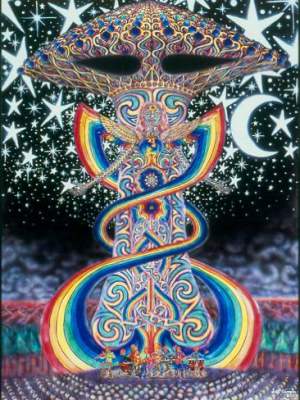
It seems that when we get the fullest possible picture of how our brains and nervous systems work at their peak, what we call logic will be a useful subset of a larger gestalt. - R.U. Sirius (Ken Goffman) from an excellent interview in Better Humans.
An excerpt:
"It started when I started a small zine called High Frontiers in the mid-80s, which was dedicated to the notion of a "neo-psychedelic renaissance." I could have called it a techno-psychedelic renaissance since that was largely what it was about. High Frontiers published about once a year from 1984 to 1988. It was well-liked within the zine world, reaching a circulation of about 20,000, which was good by those kinds of standards. Plus we had several lifetimes worth of fun as I'm sure some of your readers can imagine.
I can imagine...
My personal discovery of High Frontiers initiated the most magical day of my life. It started on the evening of May 31st, 1987, when I picked up issue #3 (1987) at Tower Records in Palo Alto, CA. where I happened to be working that summer. When I found and then browsed this astounding magazine, I quickly realized I had found a most remarkable treasure. I bought it immediately and took it home. I still think this is the single most amazing publication I have ever read to this day. That night I stayed up late in bed reading the whole thing from cover to cover.
Very late that night I finally reached the end. In the back of the zine were many ads, including one for the Psychedelic Shop on Market Street in downtown San Francisco. I had never been to anything 'psychedelic' before, and saw this as my chance to go up there and experience some of the culture, which obviously still seemed to be alive as evidenced by this magazine by RU Sirius. So naively, I wandered up to SF the next morning on June 1st, 1987. I got to the shop, and was overwhelmed at all the poster psychedelic art, books and novelty items. It was amazing. Here I am a young man still in college, just a couple of years after getting away from my parents, and I'm being reborn in the heart of psychedelia. It was a sublime feeling I can't describe. I just spent the better part of the night reading all of this psychedelic stuff that was blowing my mind, it was overwhelming, and now here I am in the SF psychedelic shop. The owner could obviously see I was enthralled, and he told me I should go to Haight Ashbury. And this is where you might think I'm naive. Having read many psychedelic books, including most of Tim Leary's and Robert Anton Wilson’s stuff, Haight-Ashbury was only a vague recollection of something "sixties". And then I remembered, "Oh yeah! Summer of Love!” So I took the map from the guy and drove to Haight Ashbury. I got there, and easily found parking, as it was a weekday. I walked just a couple of blocks and there I was standing on the corner of Haight Ashbury on June 1st, 1987 at at noon.
Then blaring on a radio from the bookstore on the corner, the DJ said that today marks the 20th anniversary to the day of the Summer of Love and the Haight-Ashbury Phenomena, as well as the release of Sergeant Peppers Lonely Heart Club! Whaaaat???! I couldn't believe it. I was blown away. Only 2 months earlier I had first learned in depth the idea of Synchronicities from Wilson's book Cosmic Trigger, and now I'm living in one. It was beyond words...
I must have stood there for another 20 minutes, just soaking in the whole thing. Believe it or not, the Haight on the day was really nice. I walked the whole thing, meandering my way into Golden Gate Park, and spent the rest of the afternoon smoking some very good sativa and enjoying my walk through the heart of the 1967 Be-In. It was utterly magickal, almost as if I was there re-living it. As I slowly walked and explored my way through the park I eventually came upon the Pacific Ocean on this warm and blissful day. As I reached the shores of this large ocean, tears of joy rolling down my cheeks, I become initiated into the Great Work.
Thank you Ken.
May 01, 2004
Arnold Toynbee, Time Traveler
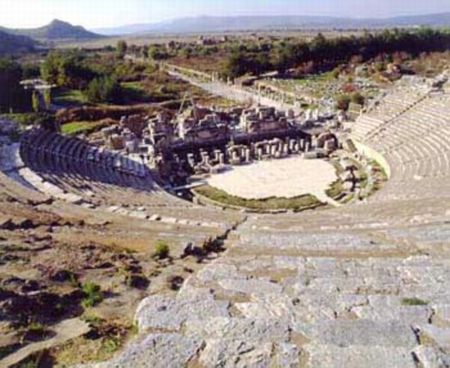
Arnold J. Toynbee was a renowned historian. His life work, "A Study of History", was a ten-volume tour-de-force, covering all of known history in considerable detail, charting the patterns to the rise and fall of a number of distinct civilizations. He wasn't just any historian. Rather, he had a unique ability to transport himself into the fabric of the history he was writing about. He talked about...
"the experience of a communion on the mundane plane with persons and events from which, in his usual state of consciousness, he is sundered by a great gulf of Time and Space that, in ordinary circumstances, is impassable for all his faculties except his intellect. A tenuous long-distance commerce exclusively on the intellectual plane is an historian's normal relation to the objects of his study; yet there are moments in his mental life -- moments as memorable as they are rare -- in which temporal and spatial barriers fall and psychic distance is annihilated; and in such moments of inspiration the historian finds himself transformed in a flash from a remote spectator into an immediate participant, as the dry bones take flesh and quicken into life."So, when he visited the sites of historic events, or considered their components, he didn't just mentally catalogue them and analyze them. He oftentimes had experiences of merging into them. He just has to approach the site of the theatre of ancient Ephesus, and then...
"At the instant at which this historic panorama impinged on the spectator's eyes, the empty theatre peopled itself with a tumultuous throng as the breath came into the dead and they lived and stood up upon their feet. 'Some... cried one thing and some another; for the assembly was confused, and the more part knew not wherefore they were come together.' [Acts xix. 32.] Those two dishevelled figures must be Gaius and Aristarchus; that ineffectual-looking creature must be Alexander. What is this rhythmic roar into which the babel of tongues is resolving itself? Will Gaius and Aristarchus escape with their lives? Thank Heaven for the intrepid town clerk's promptness and presence of mind. But at the moment when the cries of 'Great is Diana' are dying down and the clerk is beginning to reason tactfully with the crowd, the life flickers out of the scene as the spectator is carried up again instantaneously to the current surface of the Time-stream from an abyss, nineteen centuries deep, into which the impact of the sight of the theatre at Ephesus had plunged him."Nothing special, you say? Doesn't prove anything? No, it doesn't. Maybe he just had a good imagination. Lots of people do stuff like that. Sure, but they don't all write a comprehensive world history. Anyway, the point is one of past history, or future history, being an experiential reality you can step into. We're not talking about time travel machines here. But we're not either talking about merely mental exercises and visualizations. We're talking about a state of consciousness beyond intellect. If you want to know how it was, or how it will be - go and look. Be there.
The Diamond Age

The Center for Responsible Nanotechnology has an easily readable overview of the likely path of the development of nanotech, the timeline, the issues, the dangers.
Molecular nanotechnology (MNT) manufacturing means the ability to build devices, machines, and eventually whole products with every atom in its specified place. MNT is coming soon—almost certainly within 20 years, and perhaps in less than a decade. When it arrives, it will come quickly. Molecular manufacturing can be built into a self-contained, tabletop factory that makes cheap products efficiently at molecular scale. The time from the first assembler to a flood of powerful and complex products may be less than a year. The potential benefits of such a technology are immense. Unfortunately, the risks are also immense.In Neal Stephenson's science fiction "The Diamond Age" (which is a fabulous book), a typical apartment had a Matter Compiler in the kitchen. It was plugged into a feed of basic atomic components. And then you could basically ask it to manufacture on the spot pretty much anything you'd know how to ask for. Which would be built atom by atom. It is called the Diamond Age, because diamond would become one of the easiest and all-around most useful materials to build stuff of. You just need carbon atoms, which are in plentyful supply, and diamond is a very strong material, and transparent. Your windows would quite naturally be made of solid diamond.Even a primitive diamond-building nanofactory can create products vastly more powerful than today's versions. Electrical power can be converted to motion, and vice-versa, with one-tenth the power loss and about 108 (100,000,000) times more compactly. Computers can be a billion times smaller and use a million times less power. Materials can be about 100 times stronger than steel. This means that most human-scale products would consist almost entirely of empty space, reducing material requirements and cost. Most of the rest of the product would be structural, easy to design. Even the simplest products could be software-controlled at no extra hardware cost. Manufacturing of prototypes would be quite rapid—a few minutes to a few hours. Because manufacturing and prototyping are the same process, a successful prototype design could immediately be distributed for widespread use. A designer working with a few basic predesigned blocks could design, build, and test a simple product in less than a day. Products with complex interfaces to humans or to their surroundings—information appliances, automobiles, aerospace hardware, medical devices—would be limited by the time required to develop their software and test their functionality. However, in some fields the high time and money cost of manufacture slows other parts of the development cycle; this effect would disappear. An explosion of new, useful products could rapidly follow the widespread availability of a nanofactory.
Anyway... in twenty years or less!!?! This is serious, folks. Yes, obviously, if somebody makes workable nano-assemblers and figures out how to power them, then one thing will take another, very quickly. Then they can build duplicates of themselves. And then hardware suddenly is just a matter of software. I.e. you need just some raw atoms and a blueprint. It is going to cost nothing. The world will never be the same. And, no, it won't just be a nice appliance to have in the kitchen. Everything will change pervasively.
So, there's a big hurry to solve the moral and organizational and
security issues around this. If anybody can download the plans for a
nuclear bomb or the ebola virus, and press a button to build them any
time they want - then what? So the race is on, to either build some
kind of sofar uninvented safeguard into such a system, or for humanity
to figure out how to organize itself so as to survive such capabilities.

